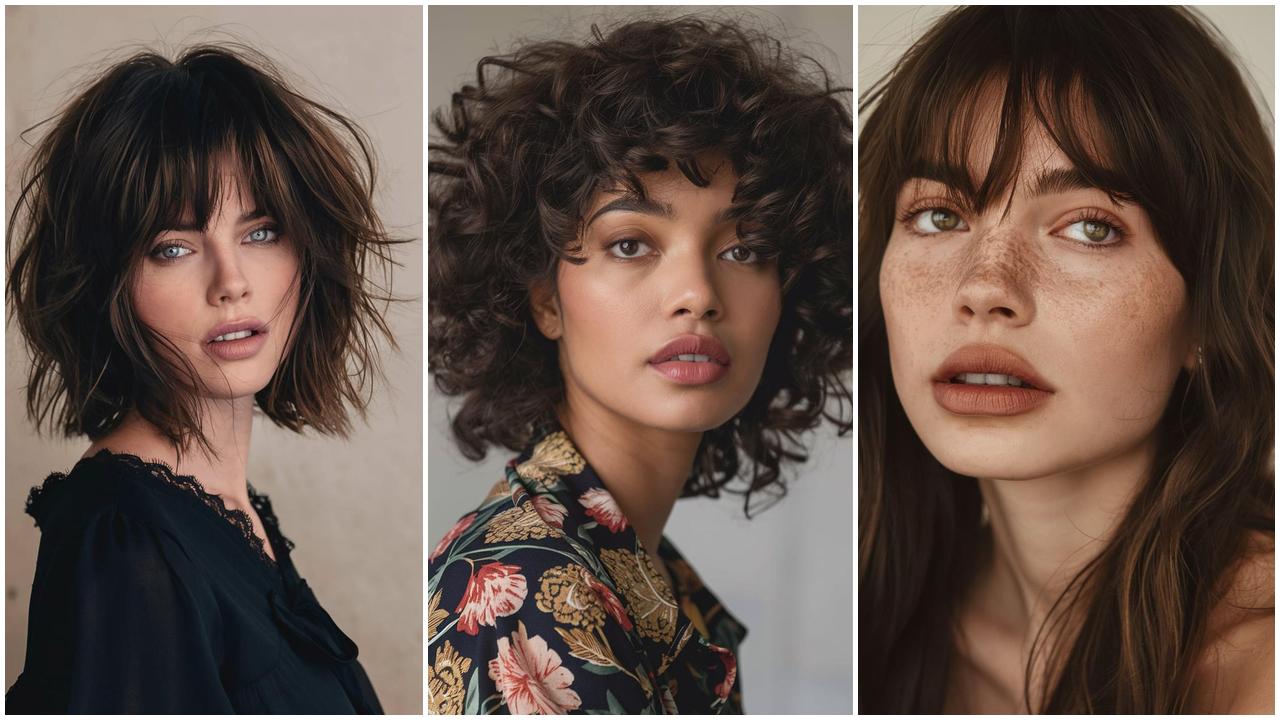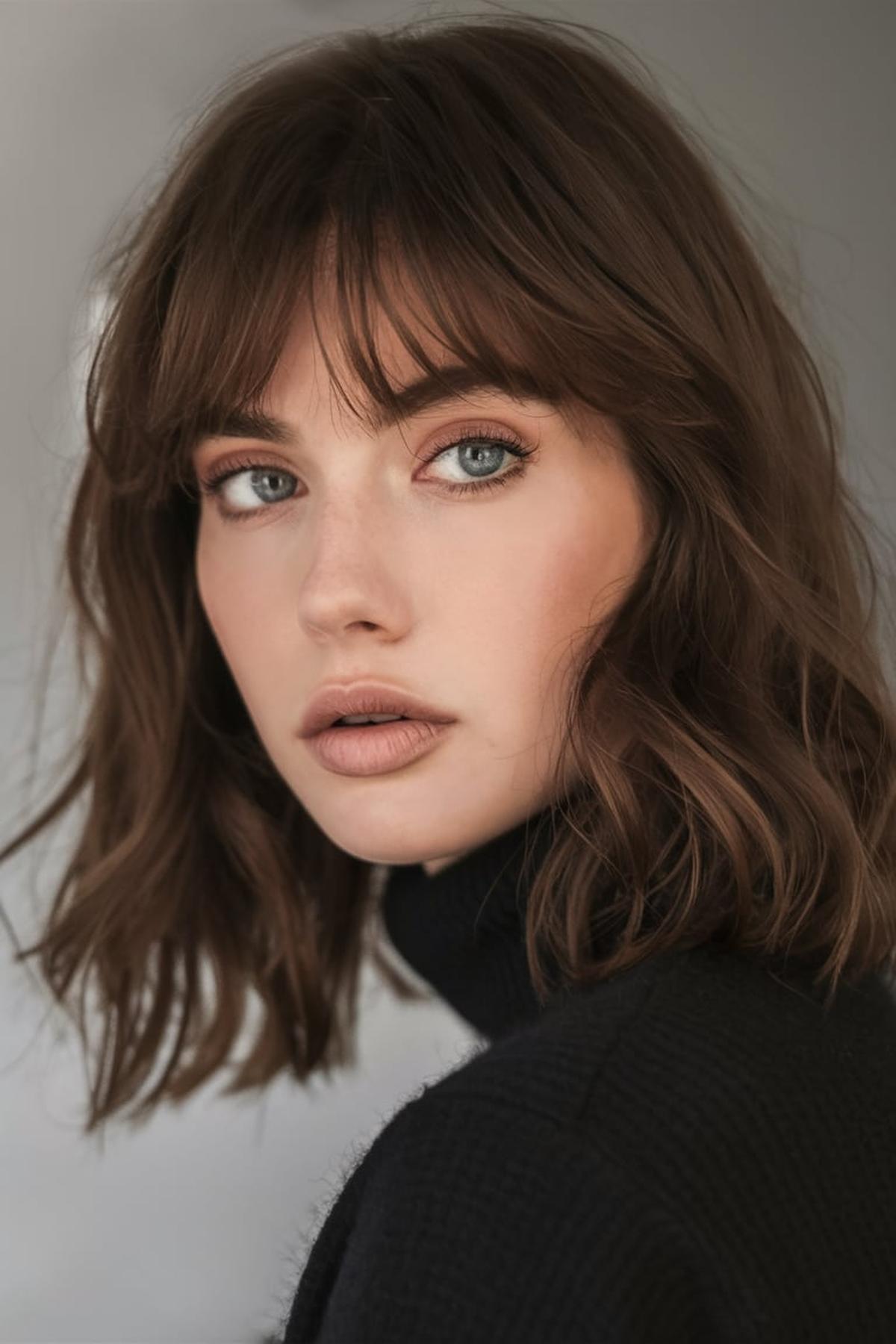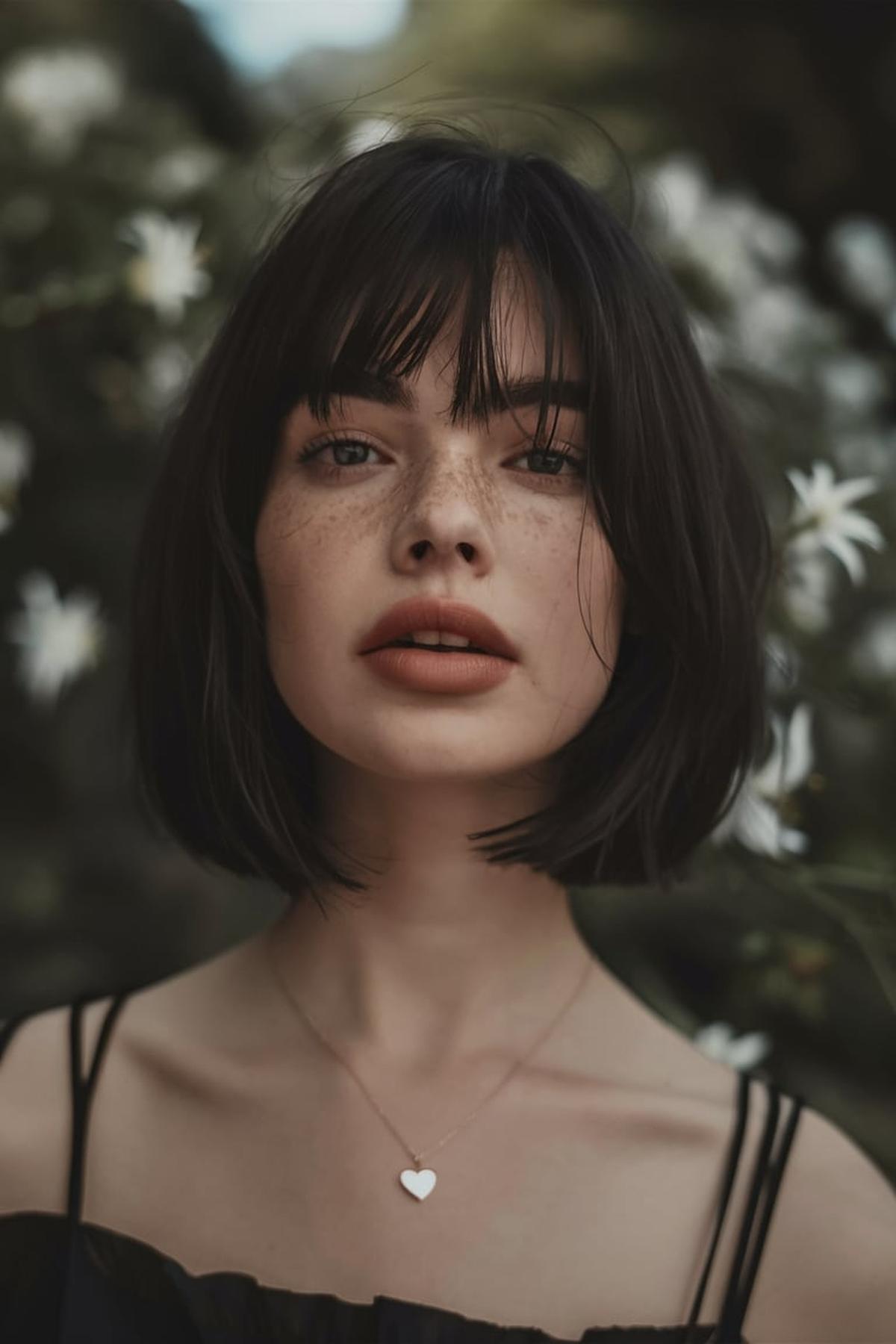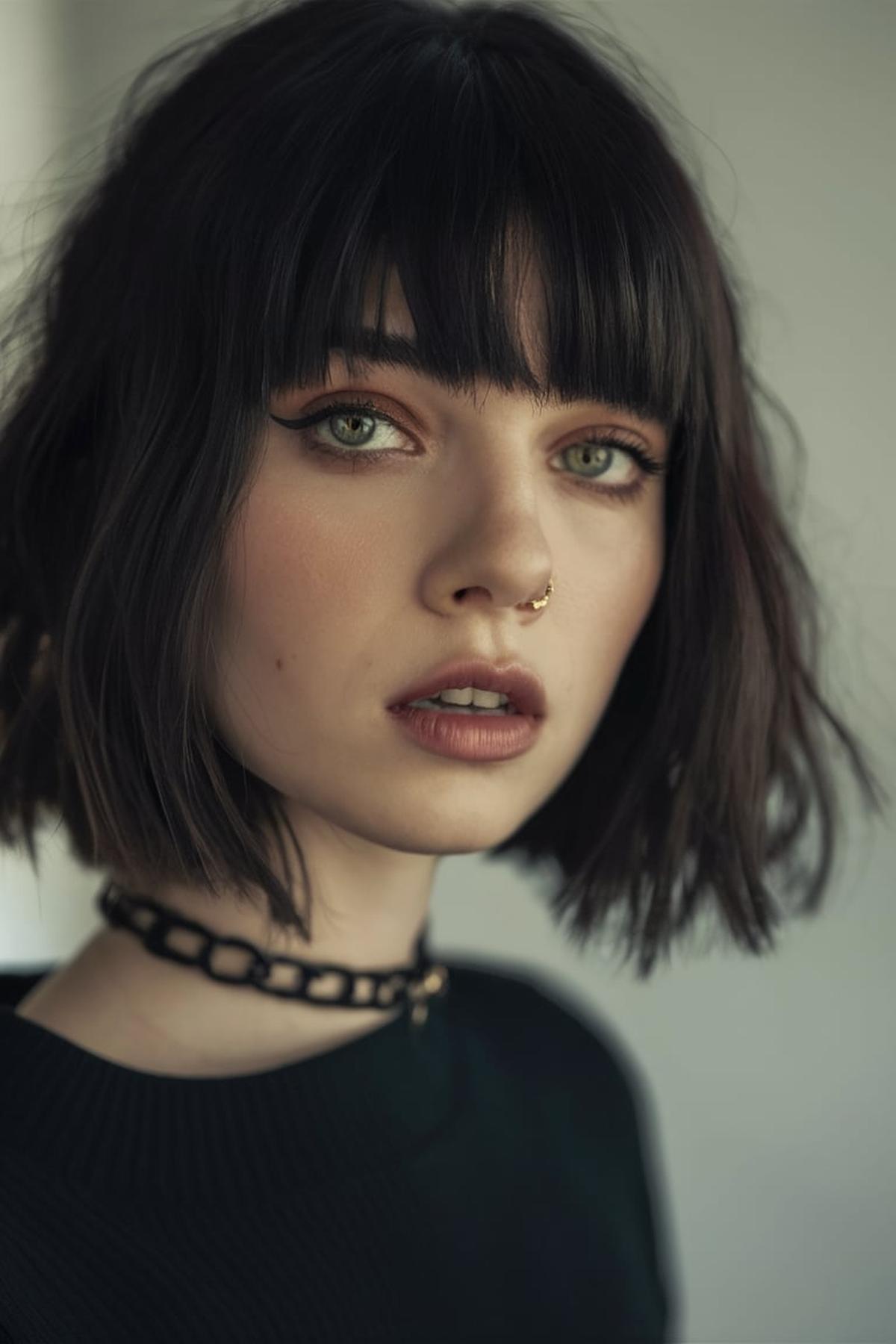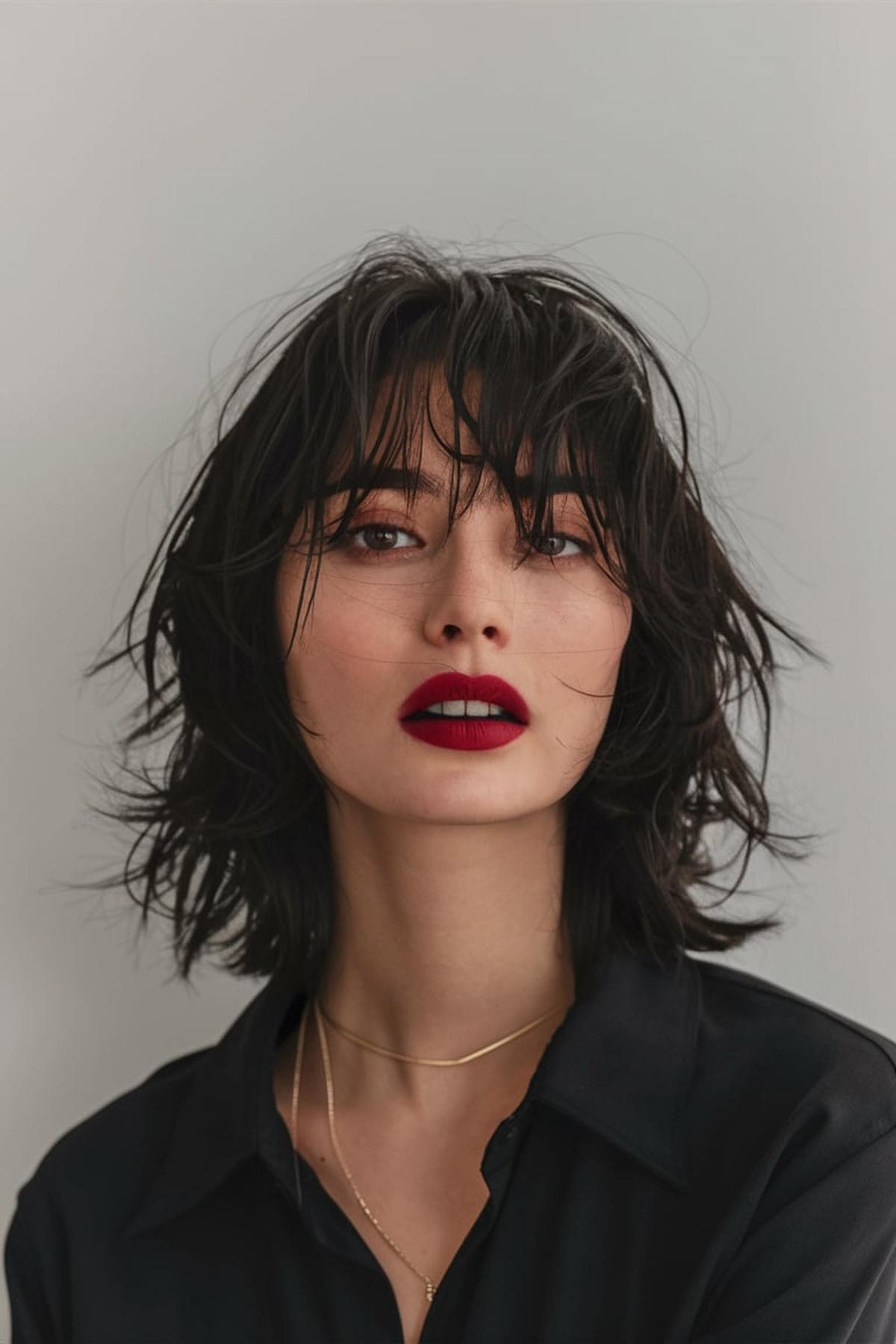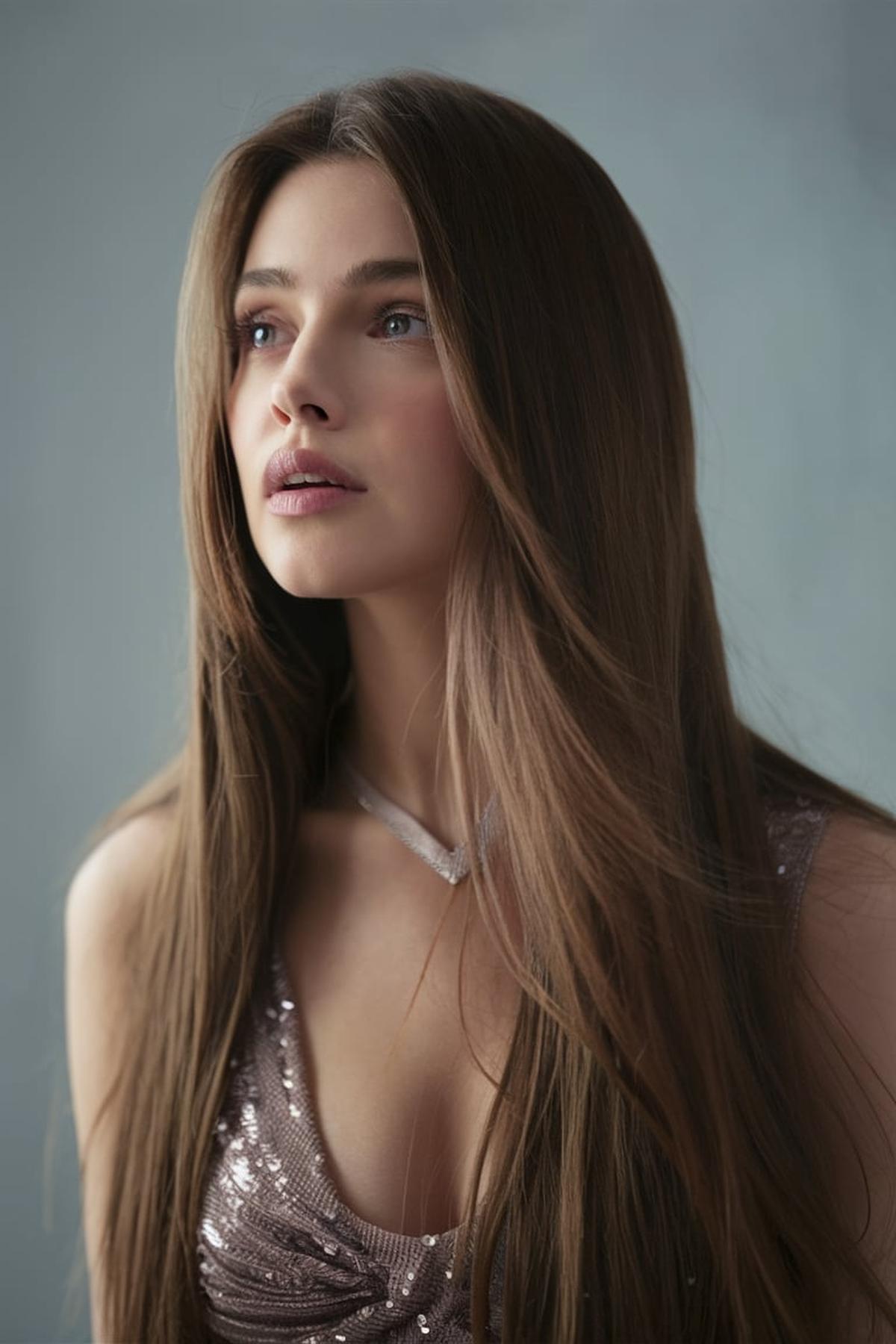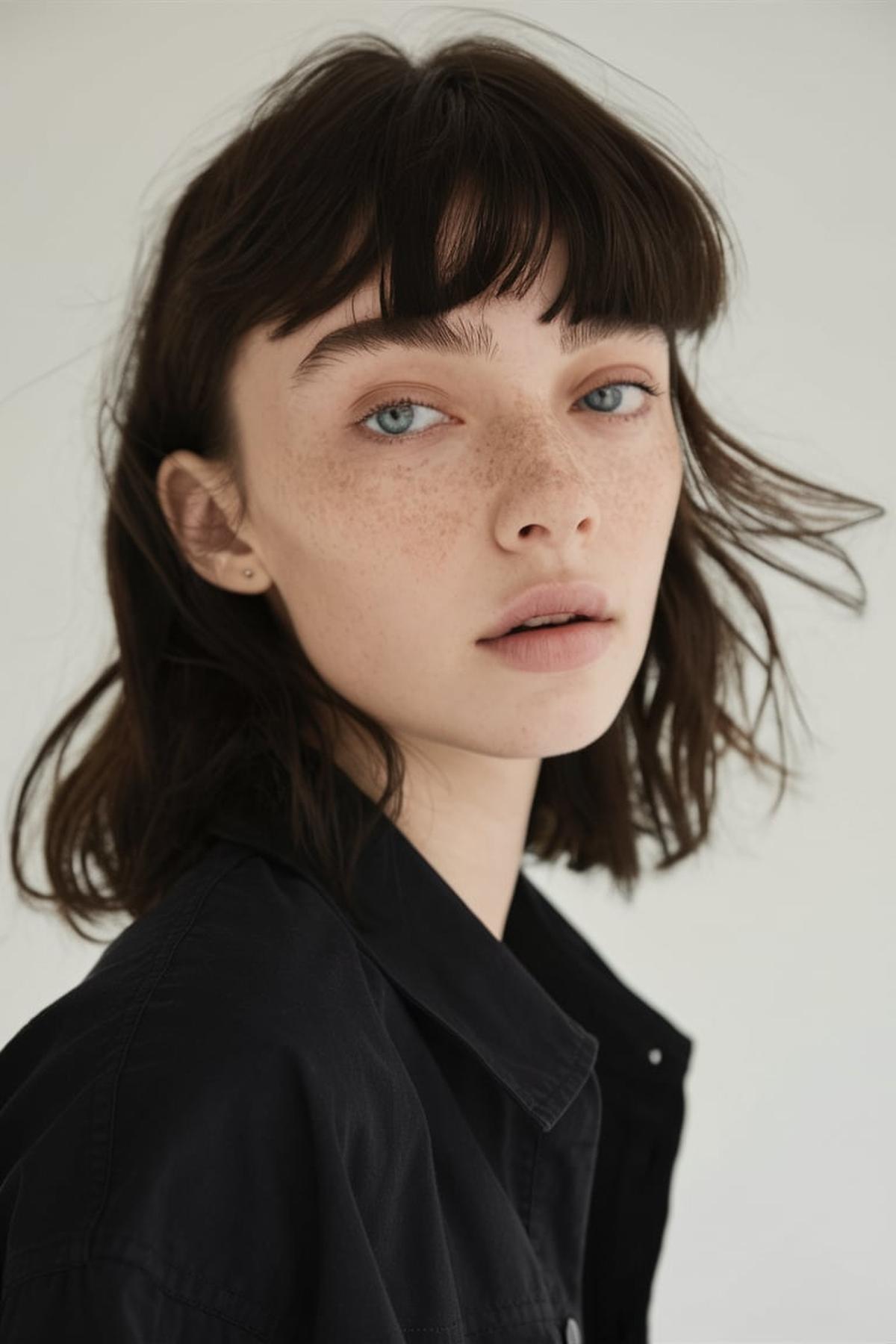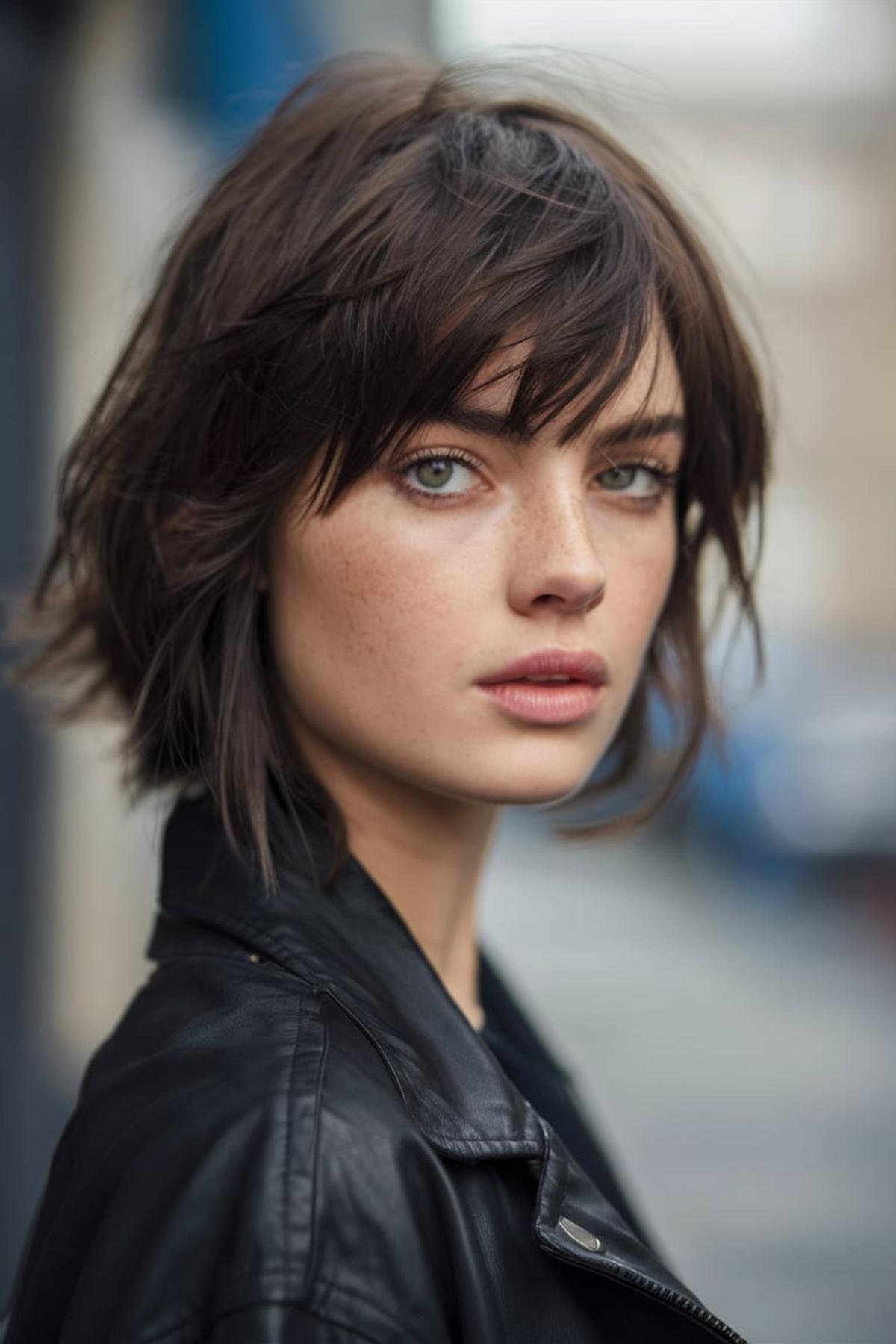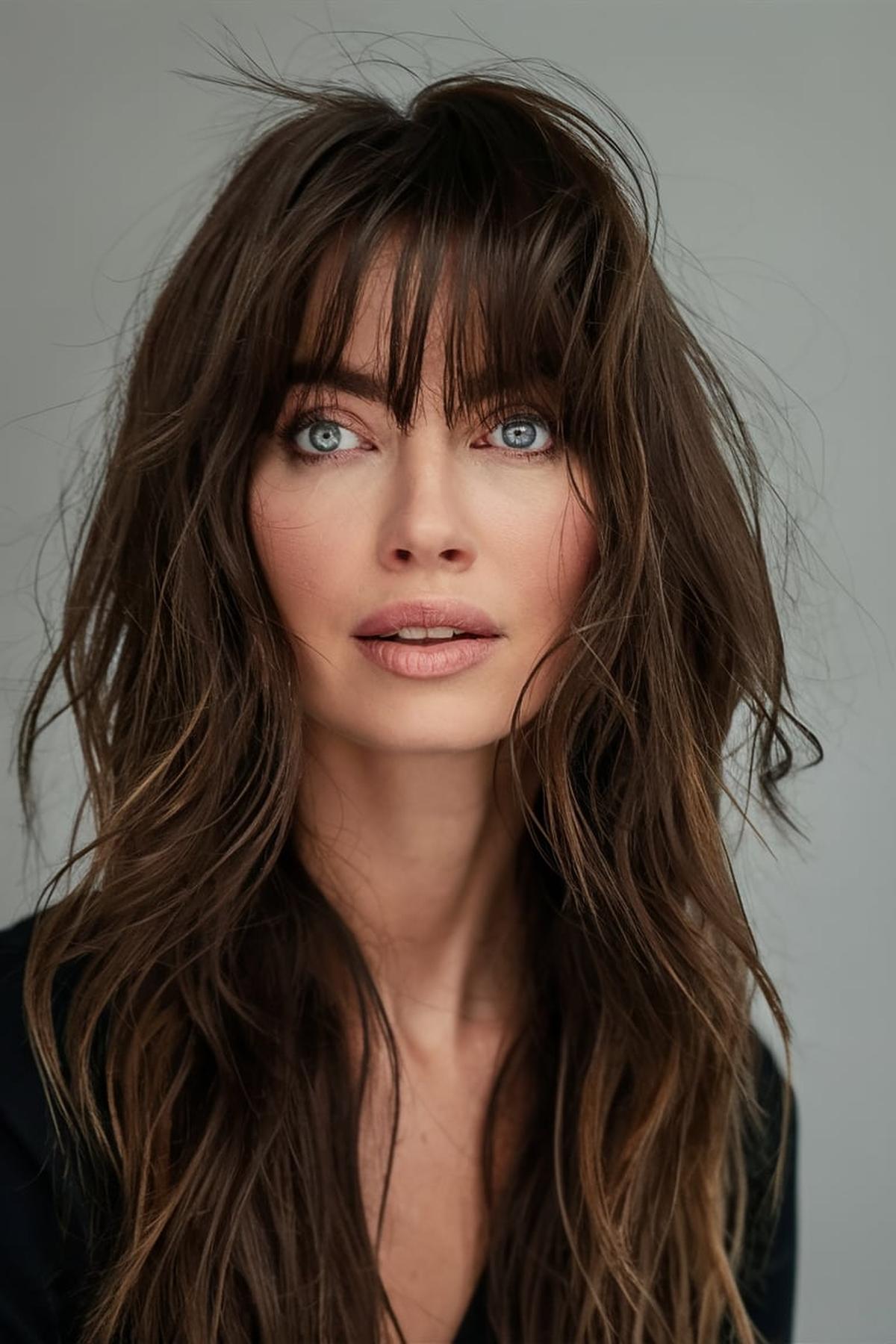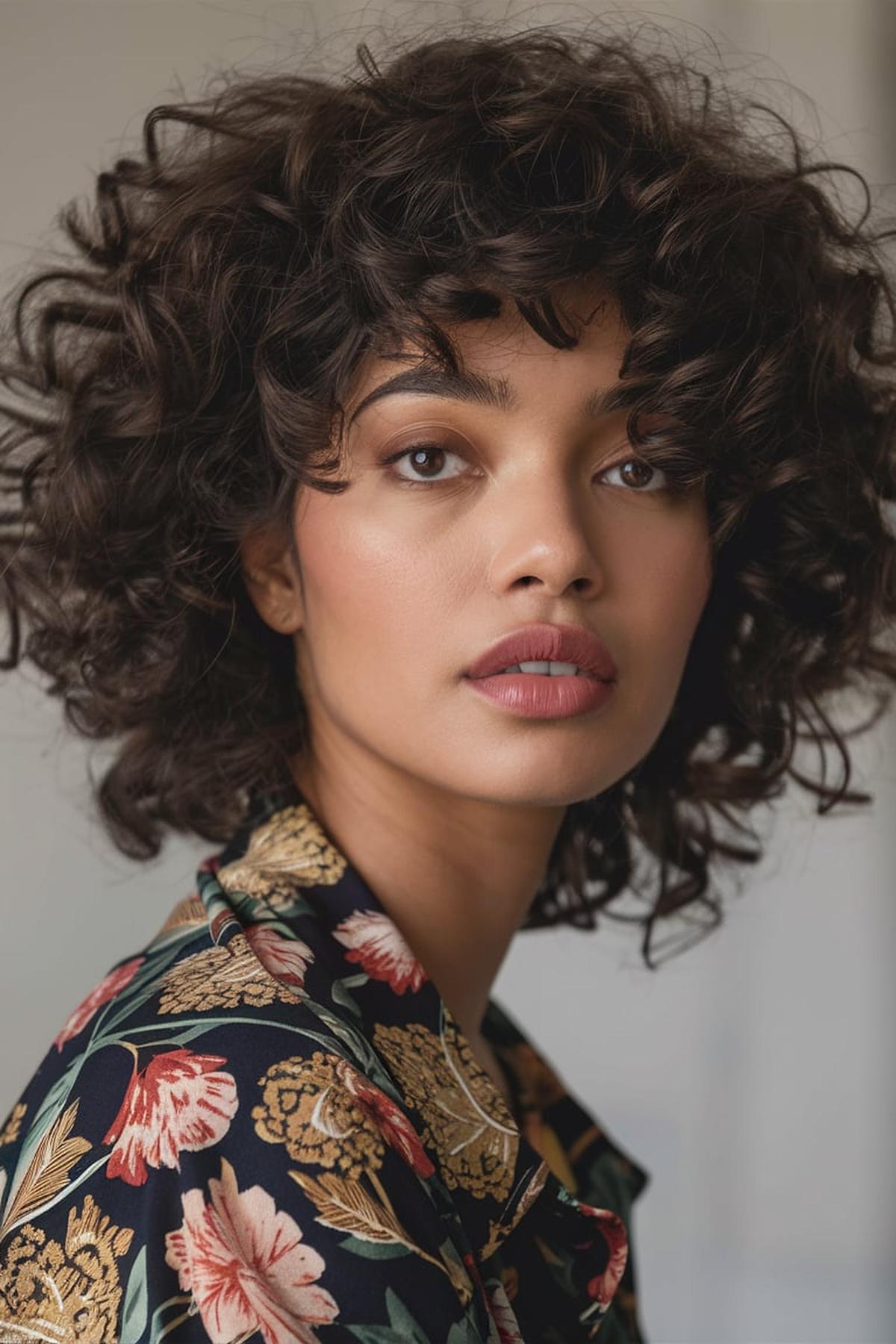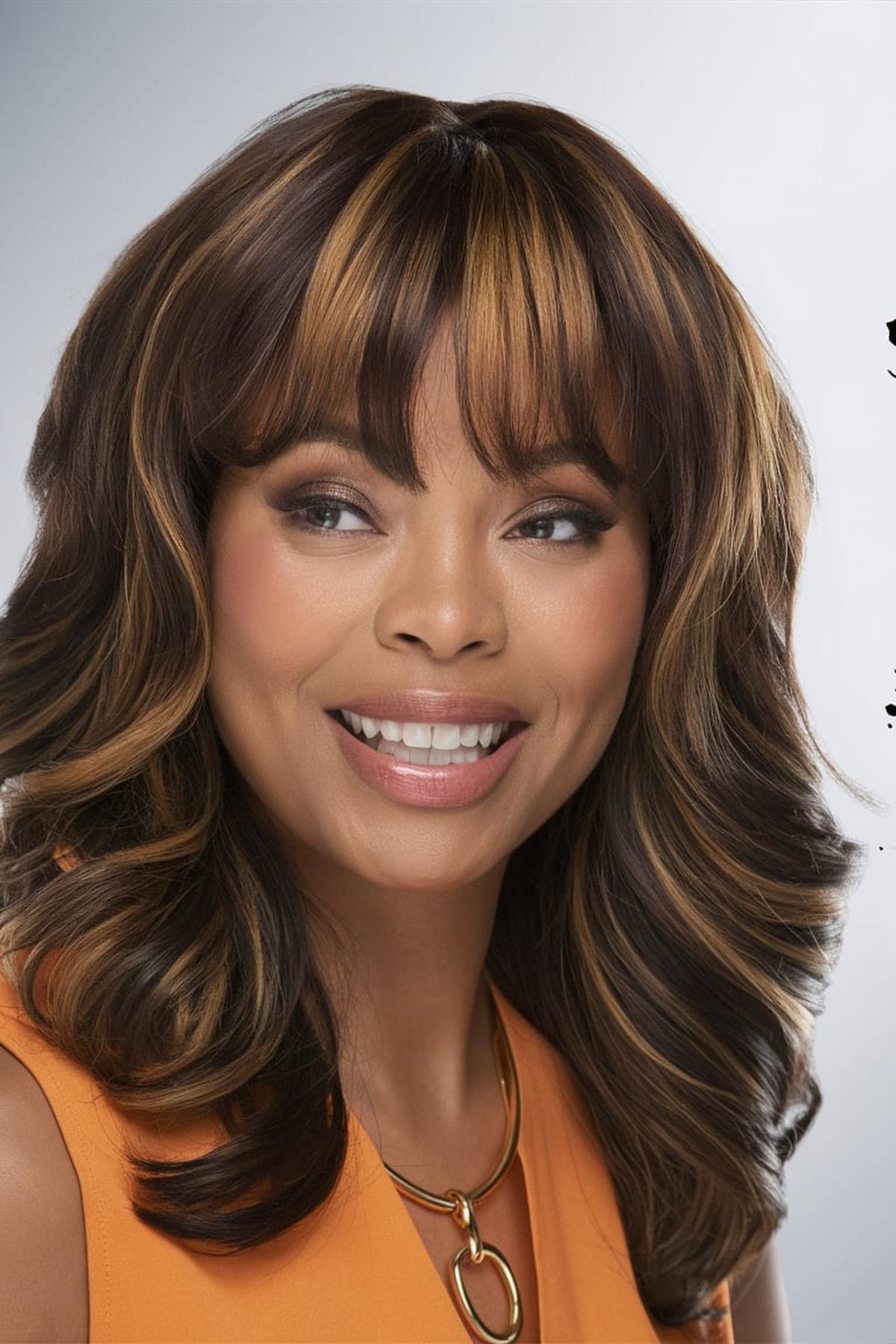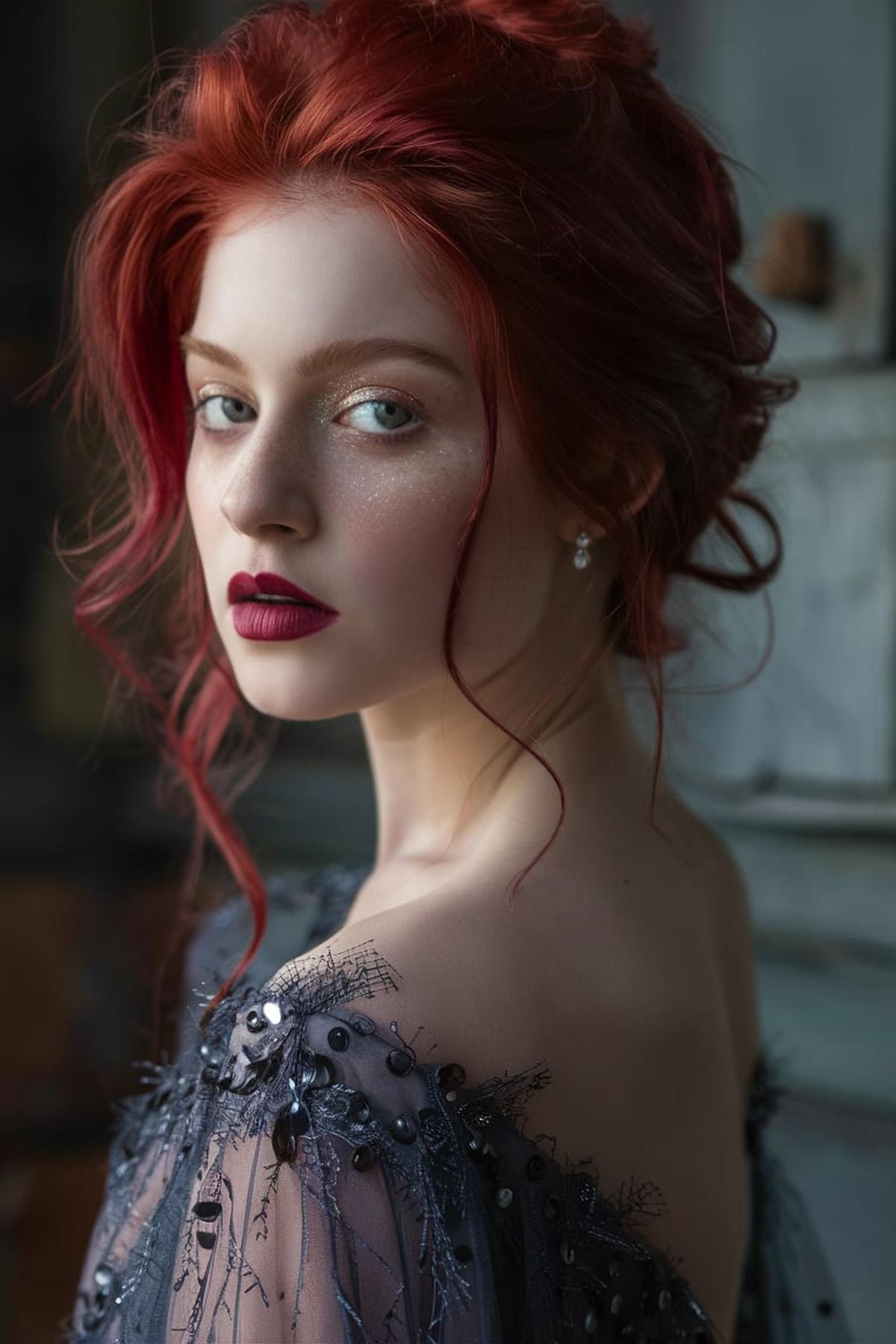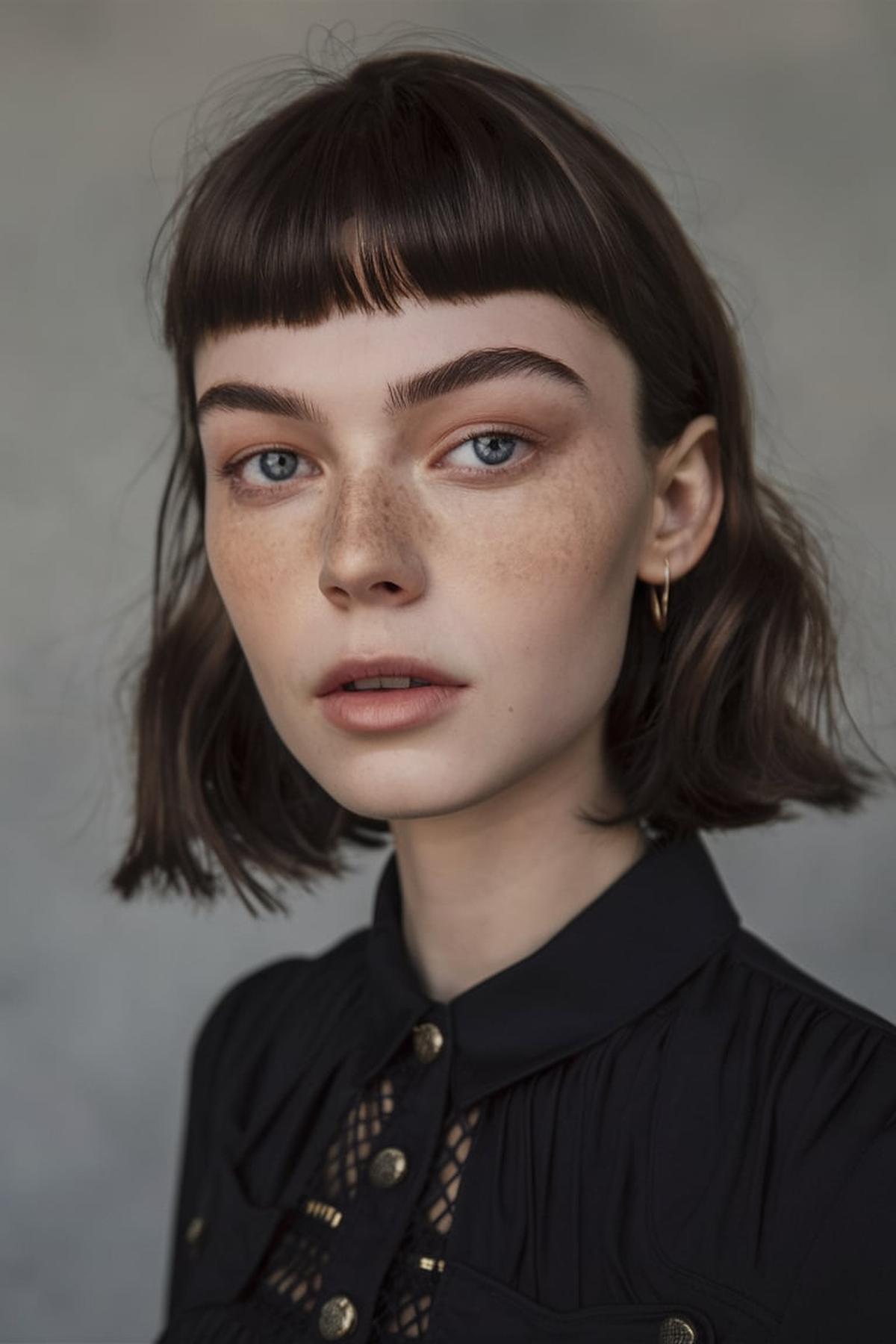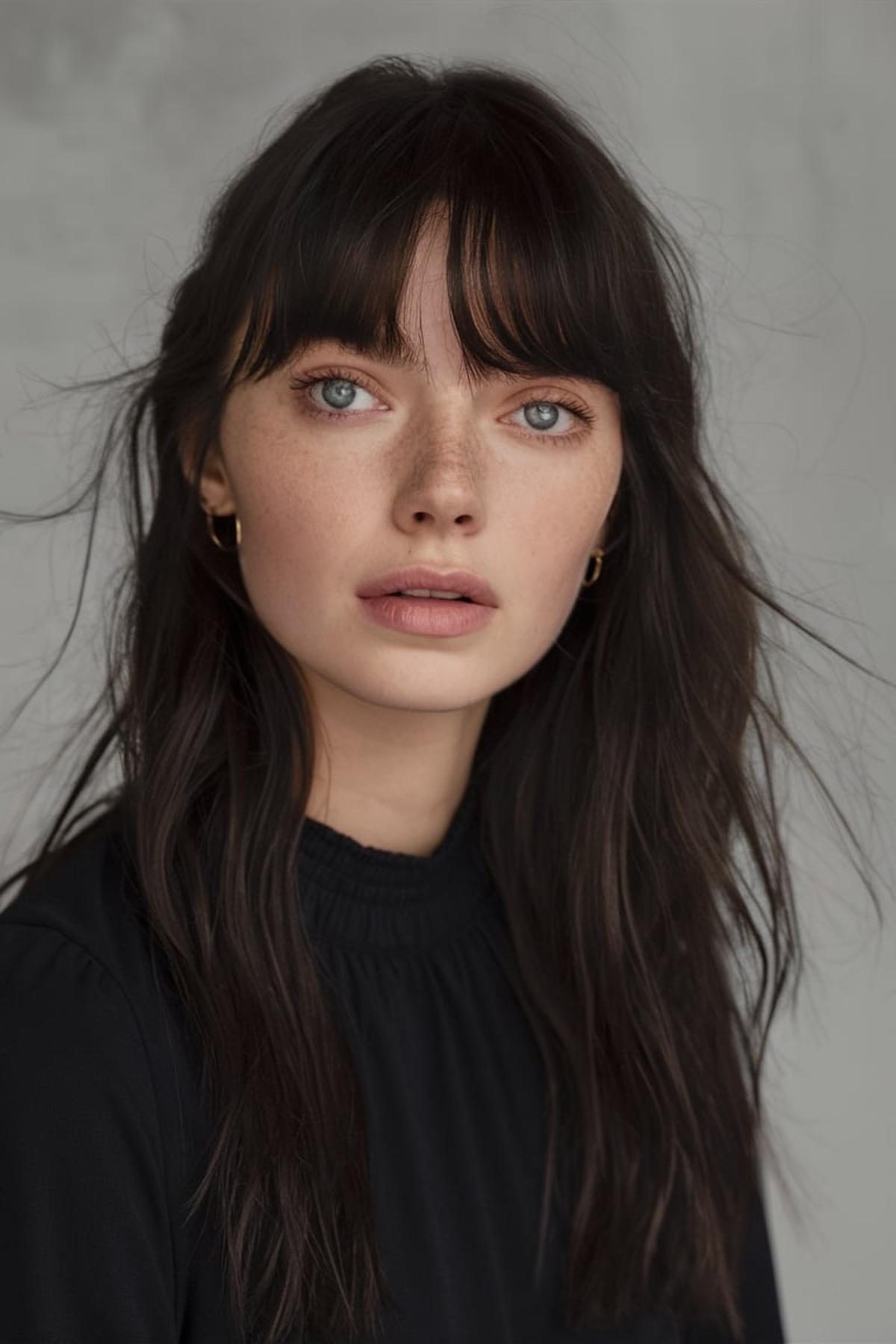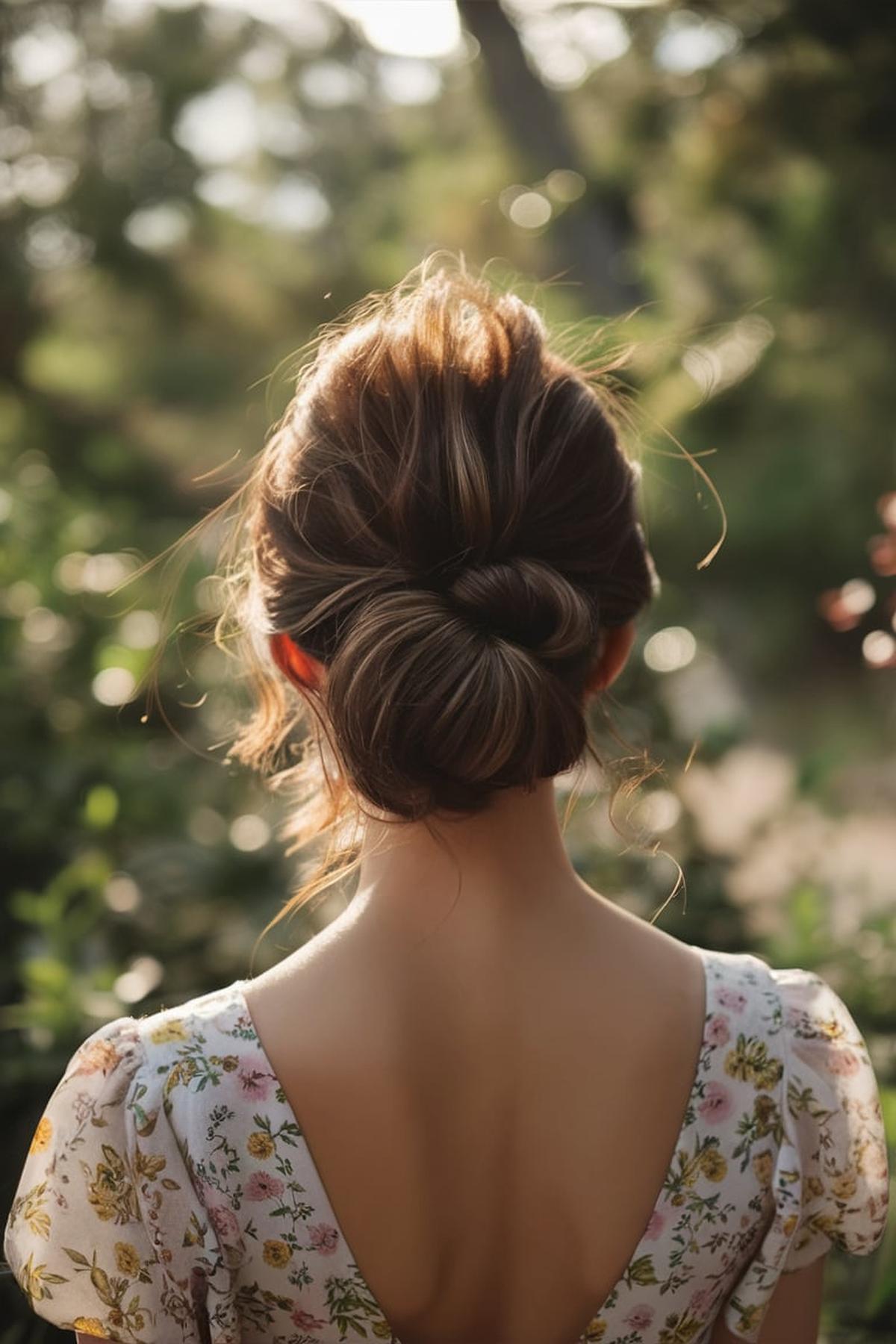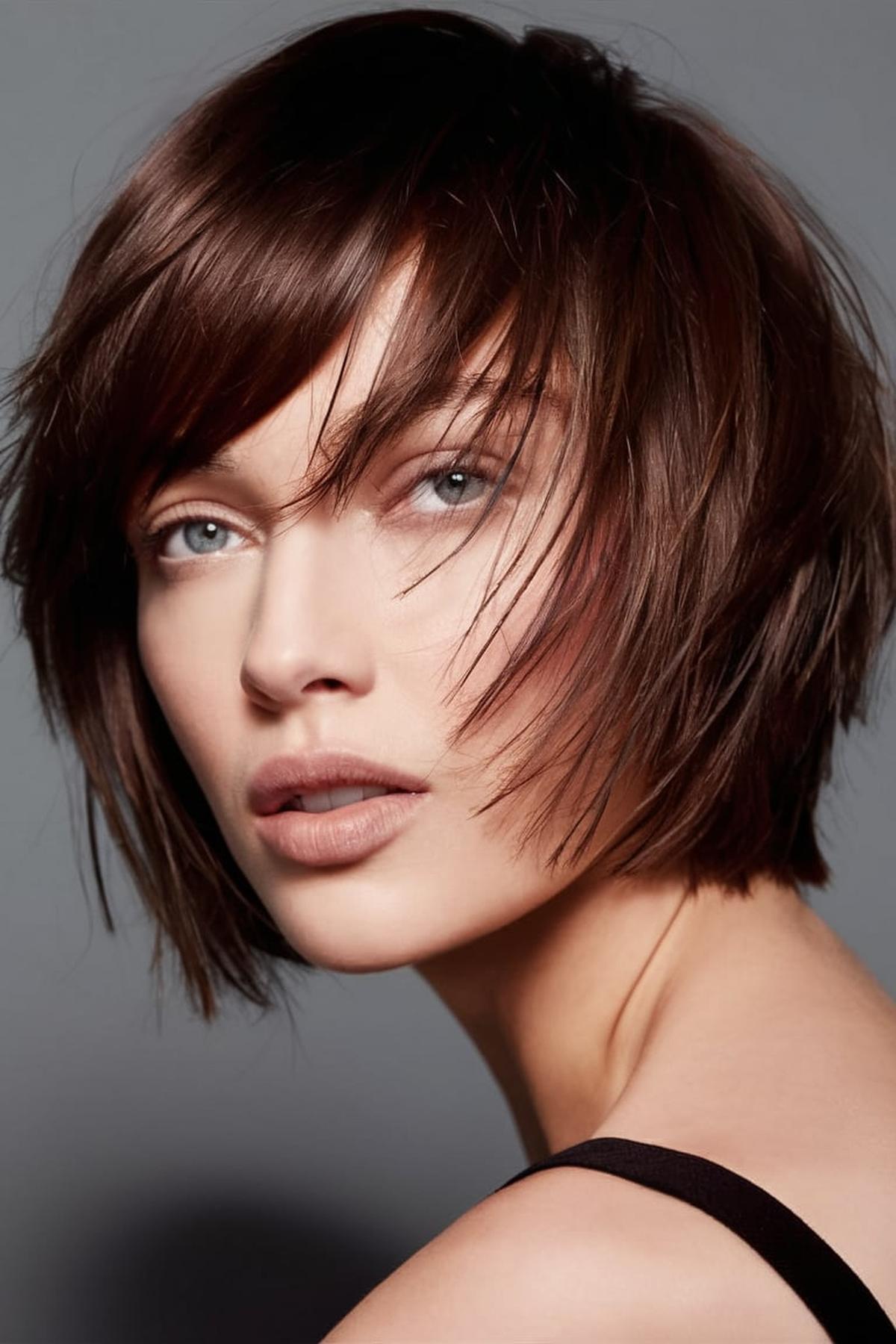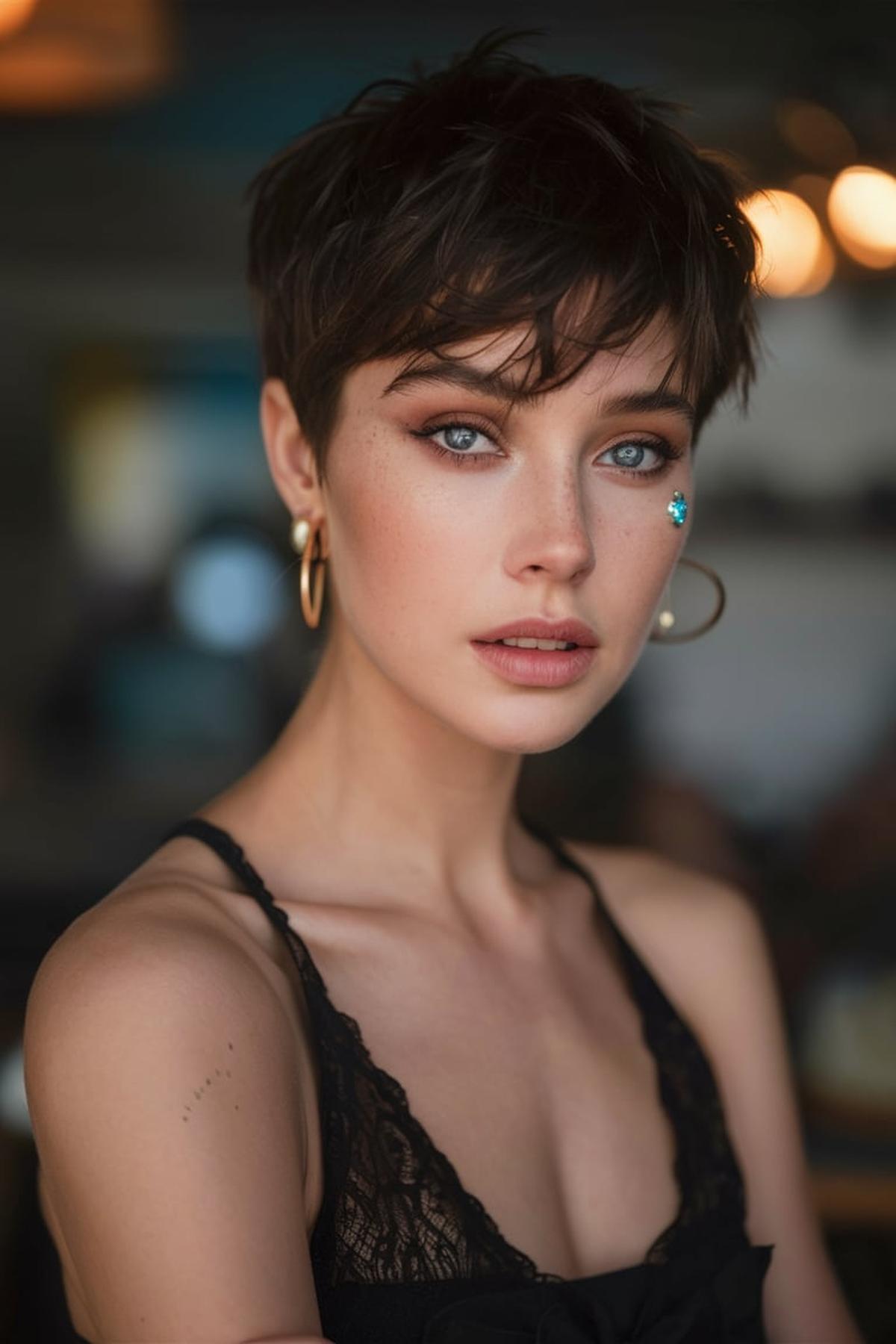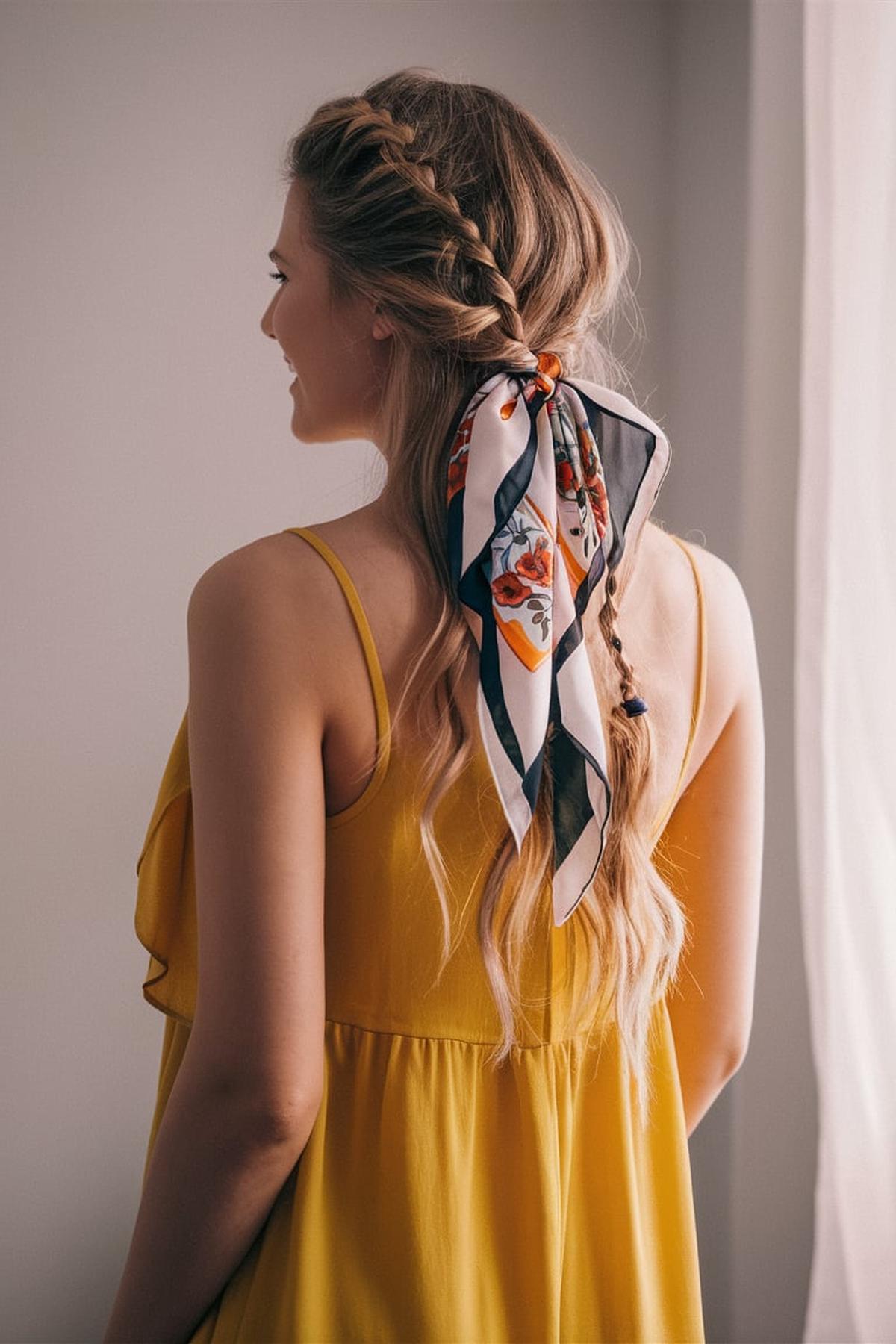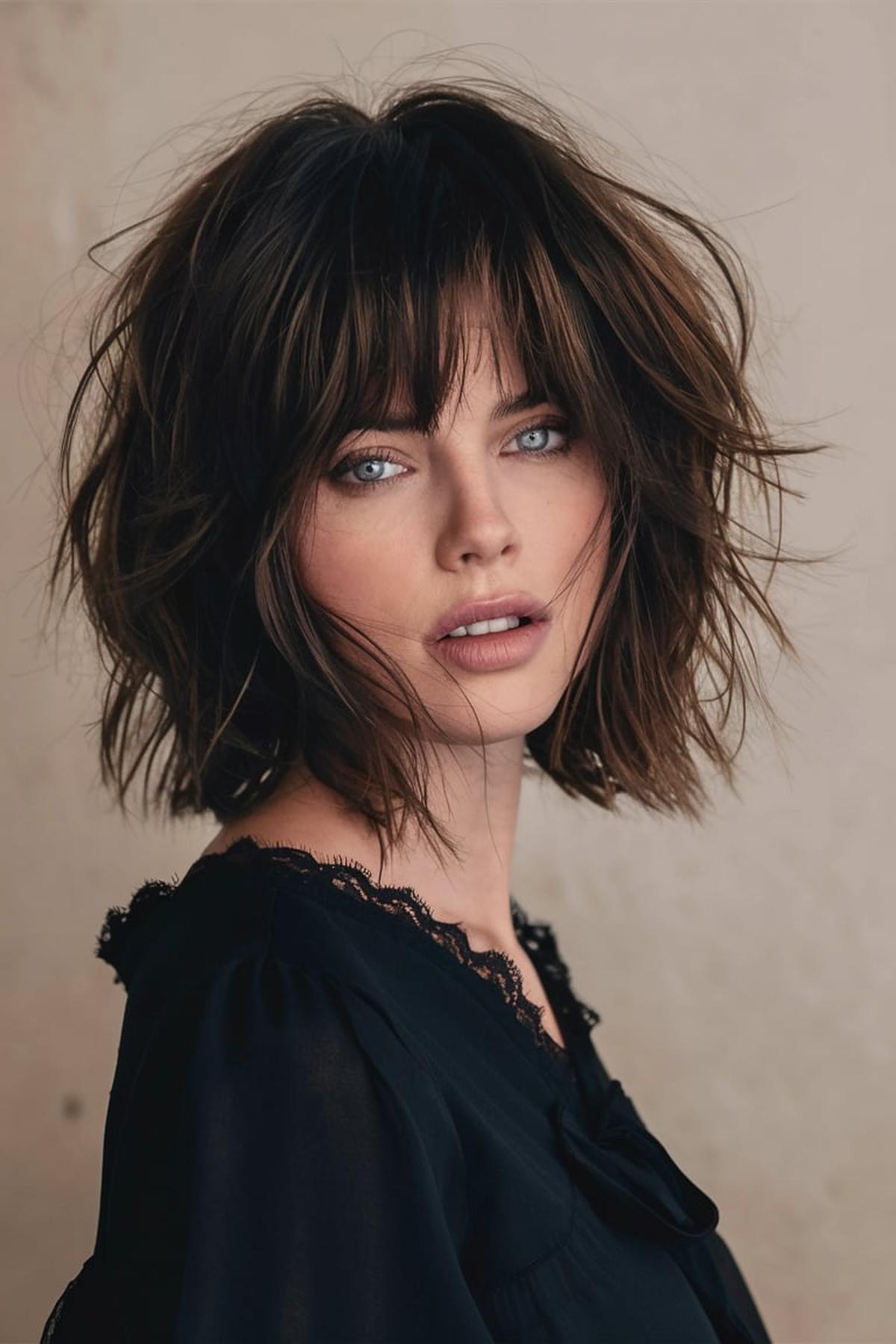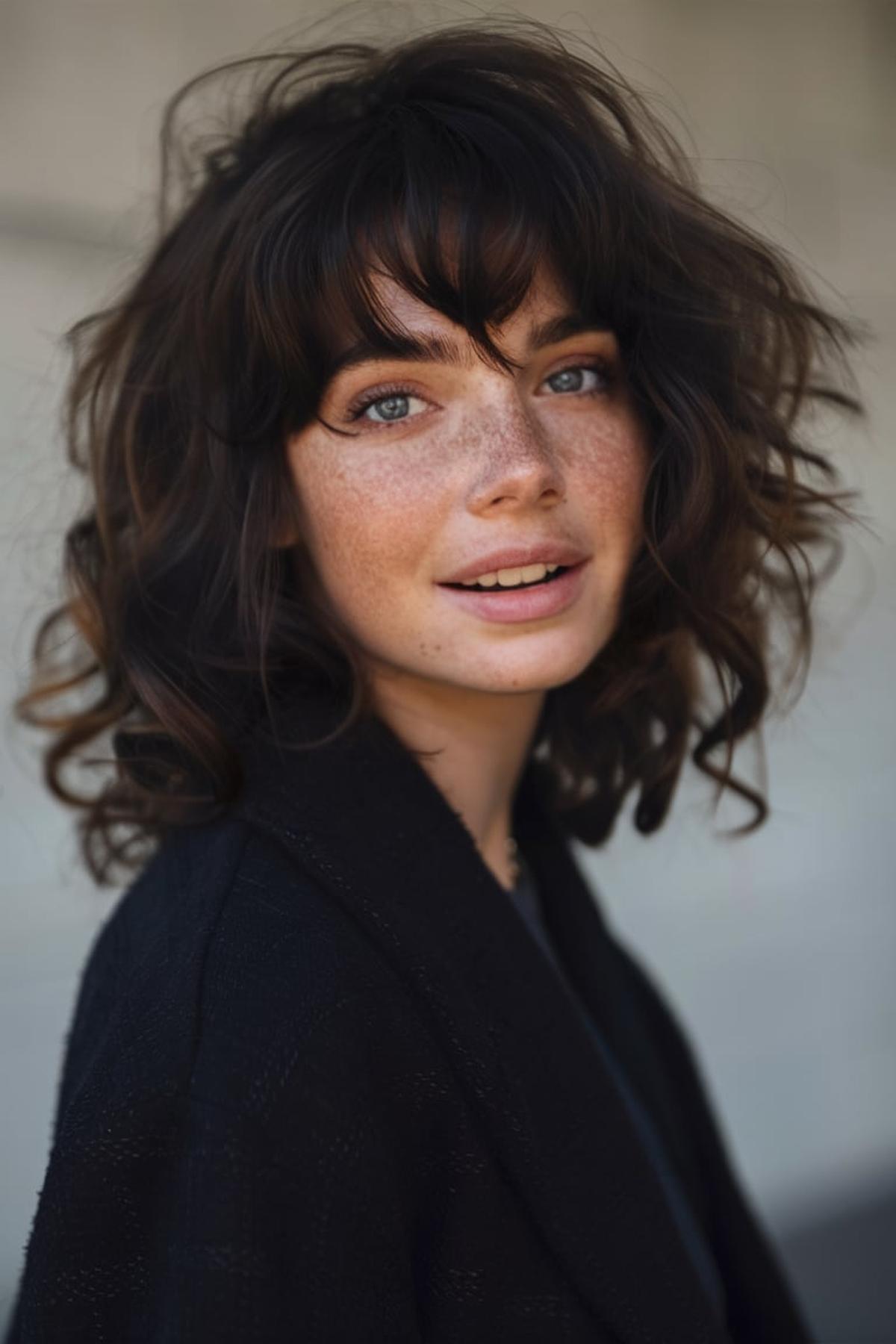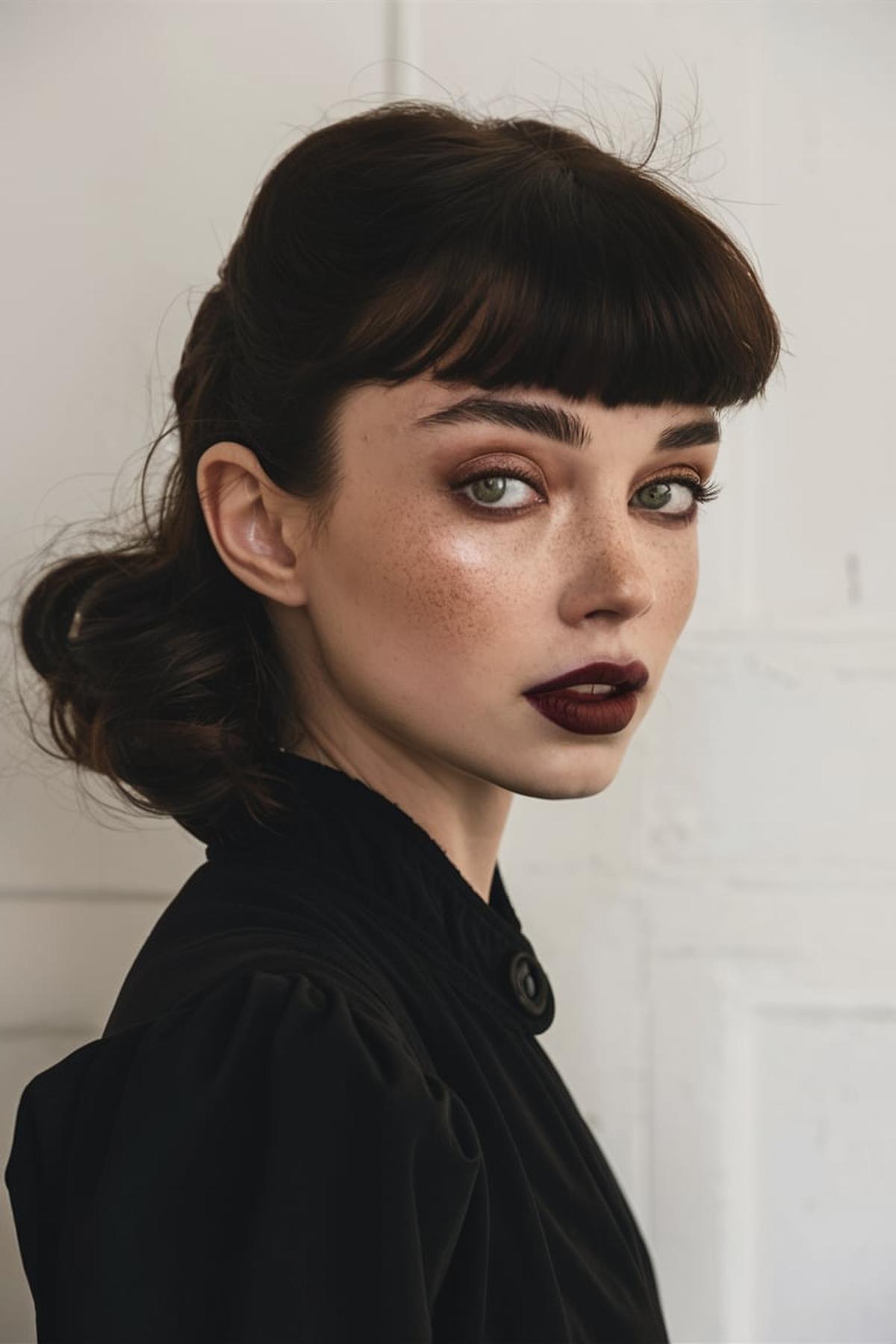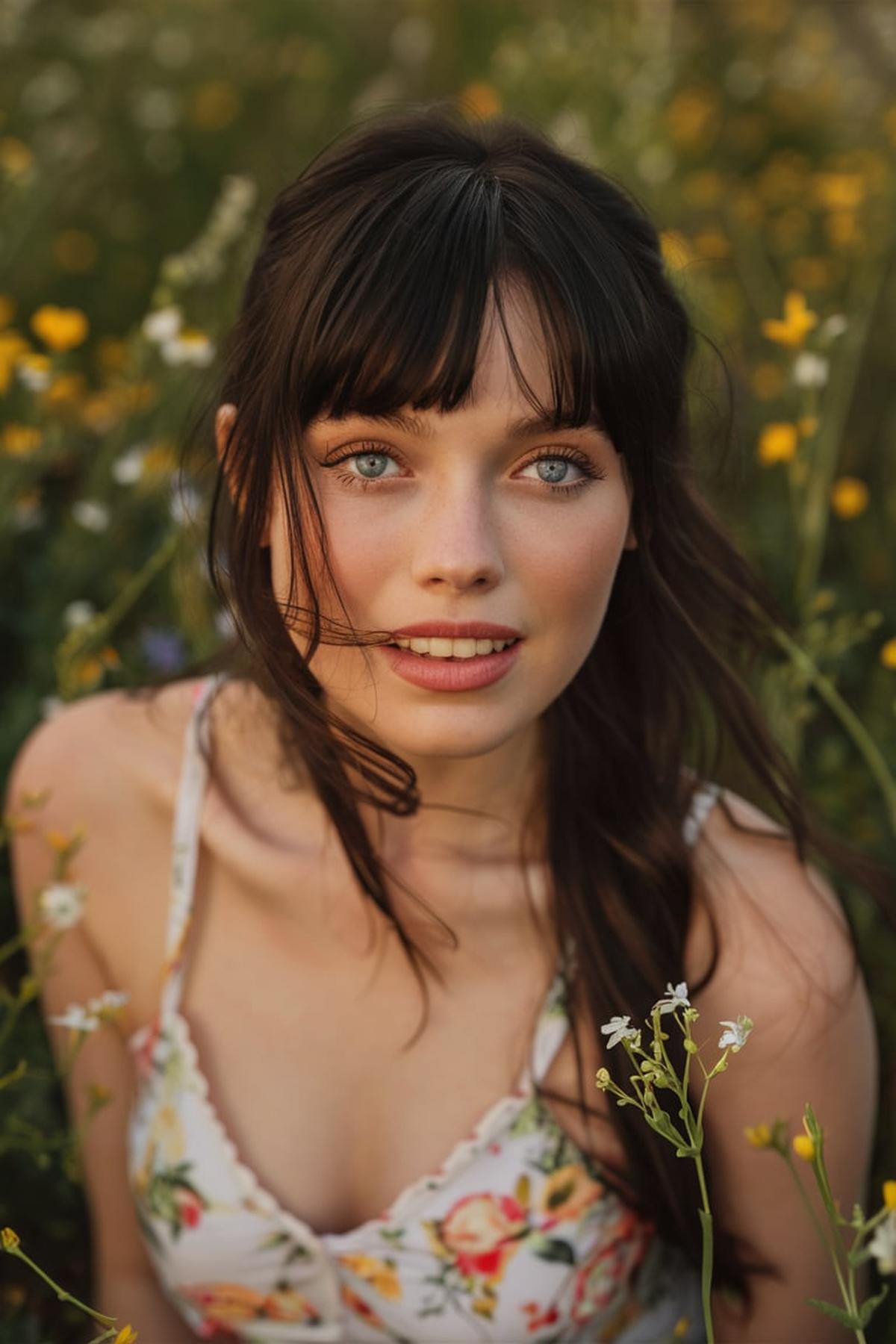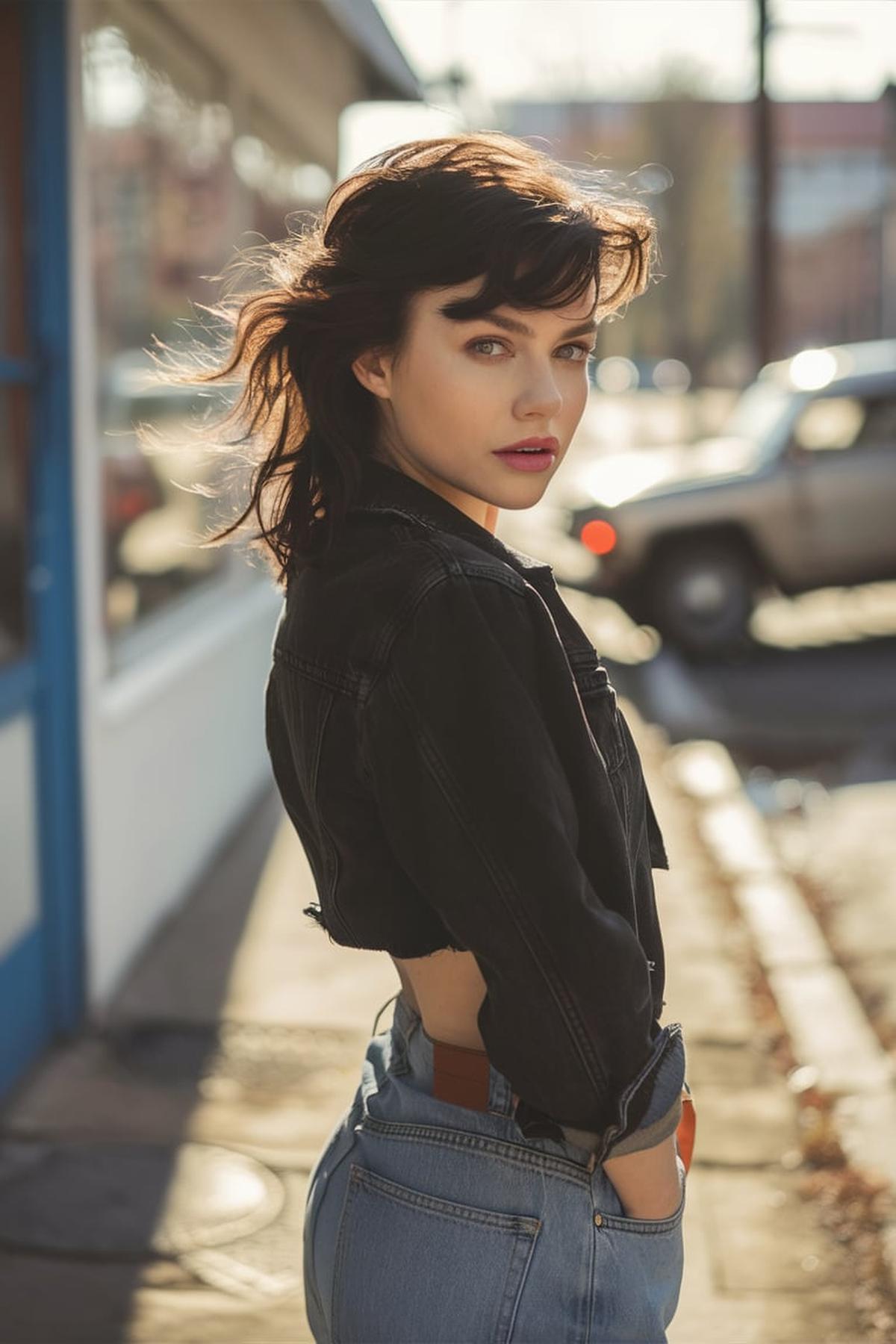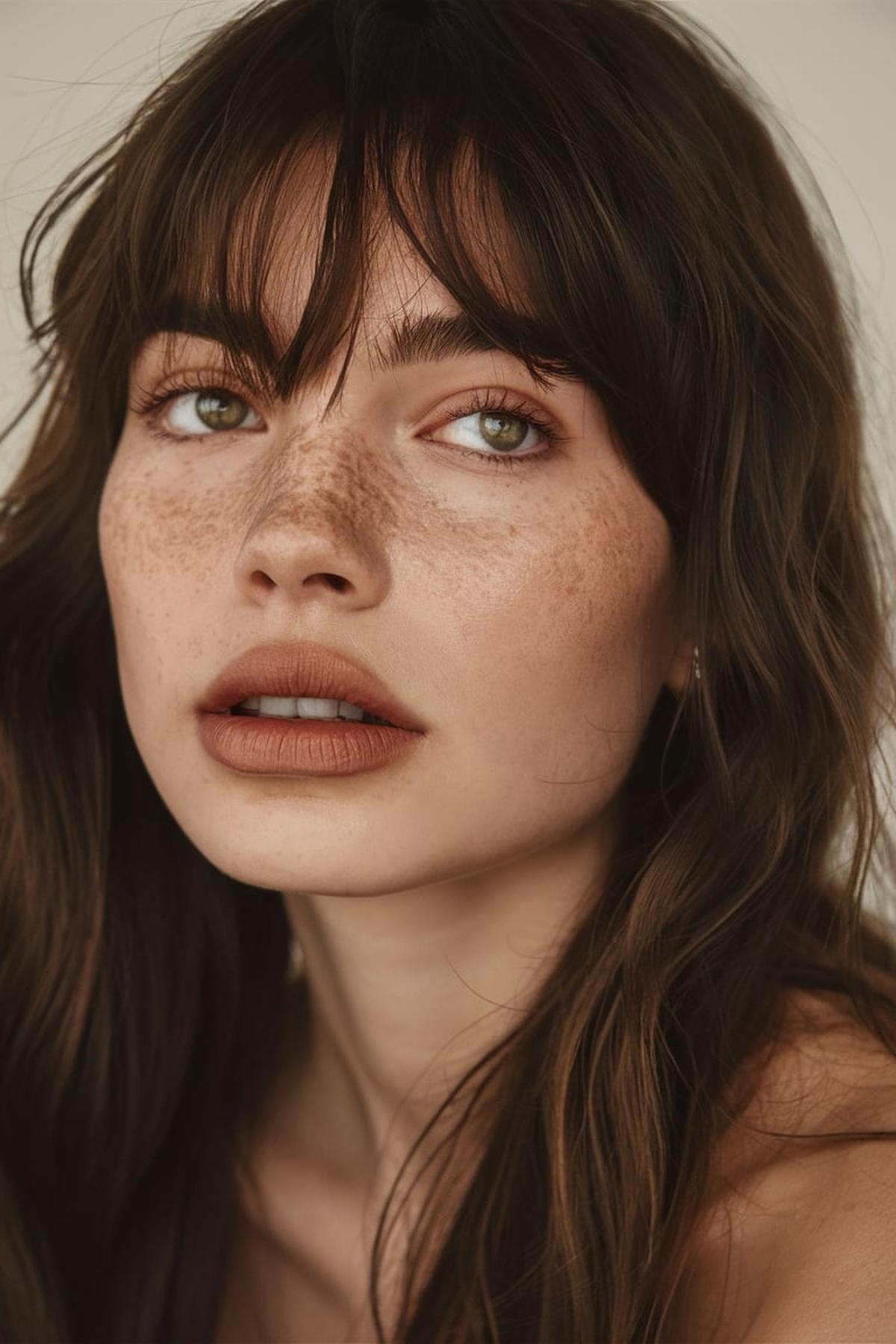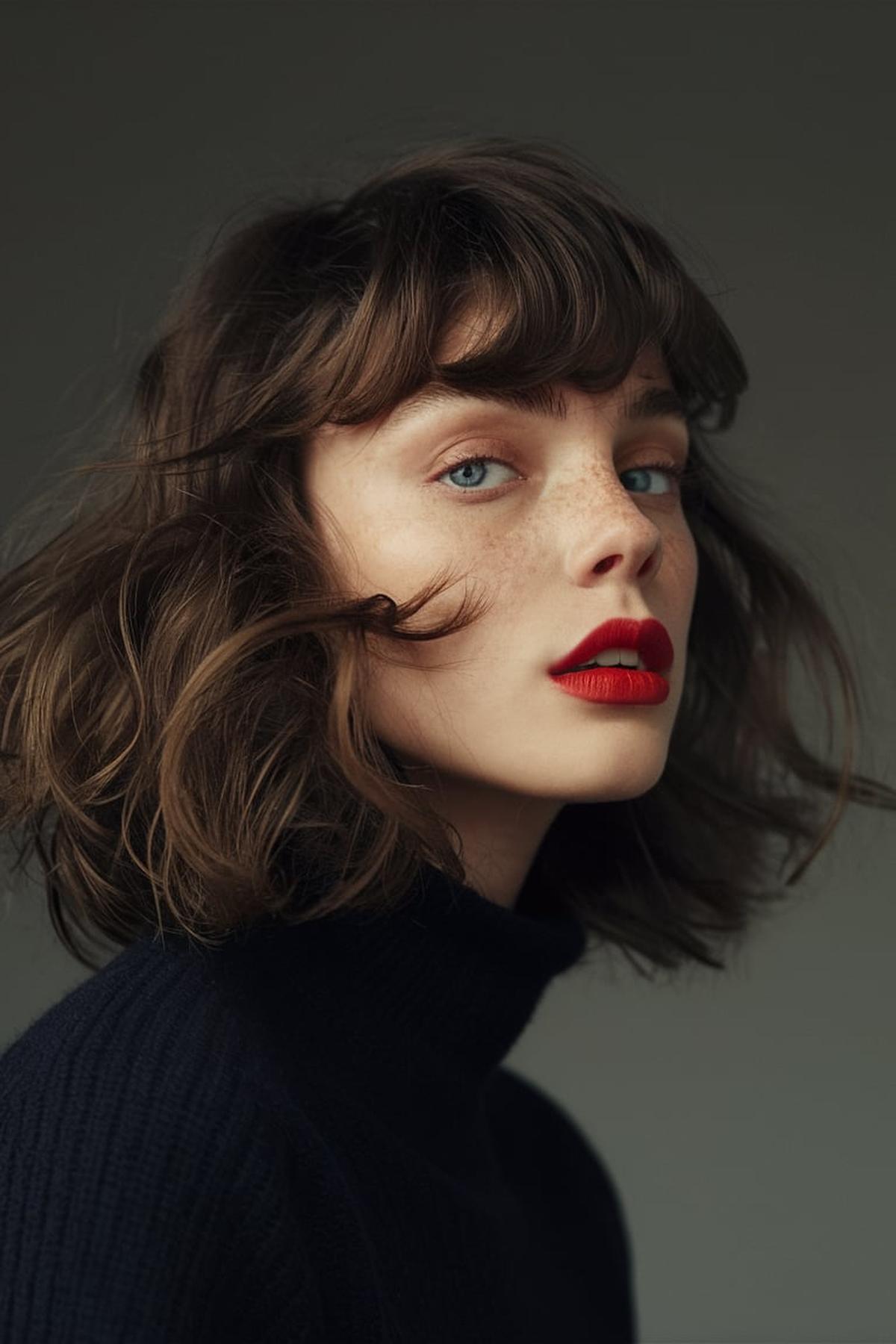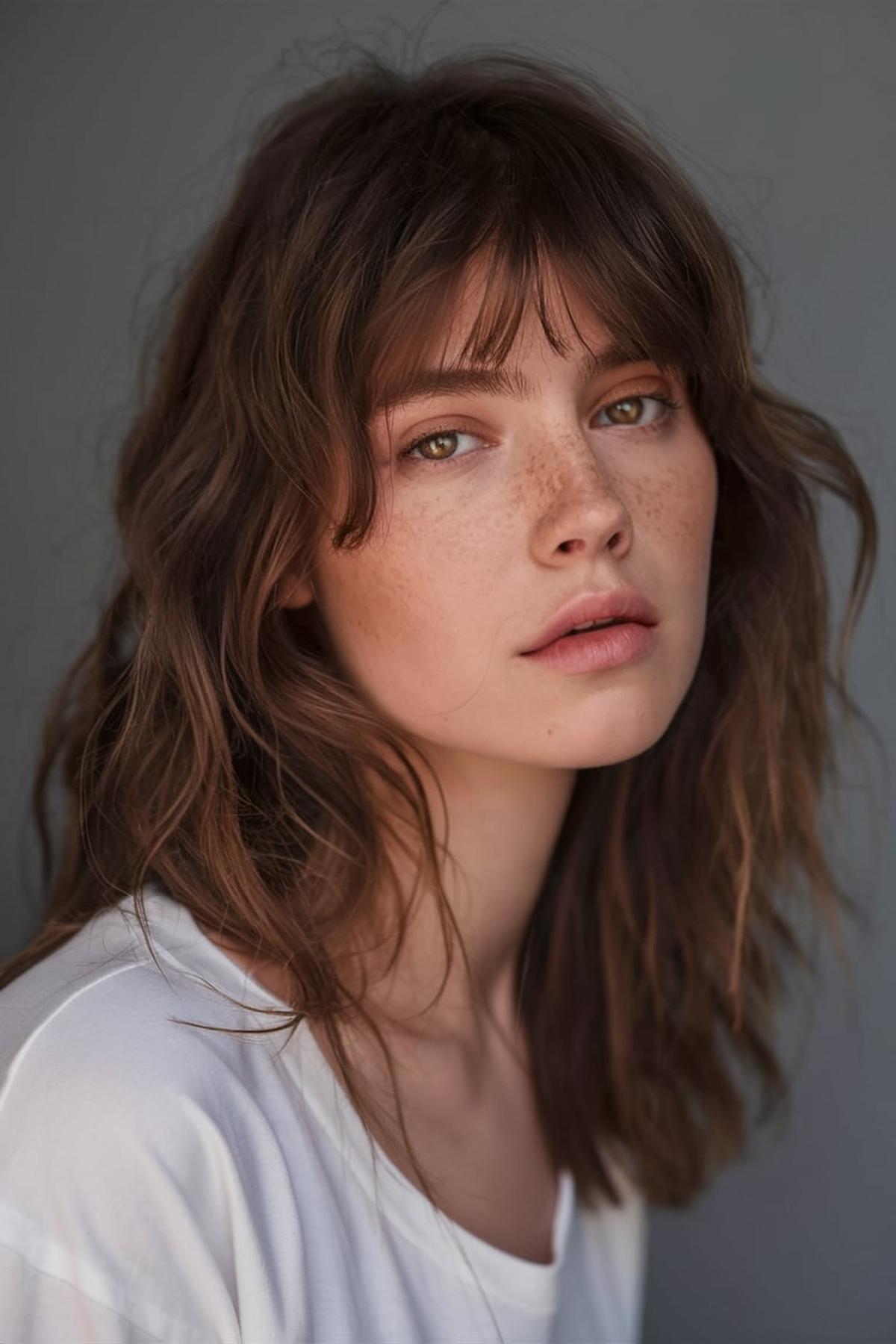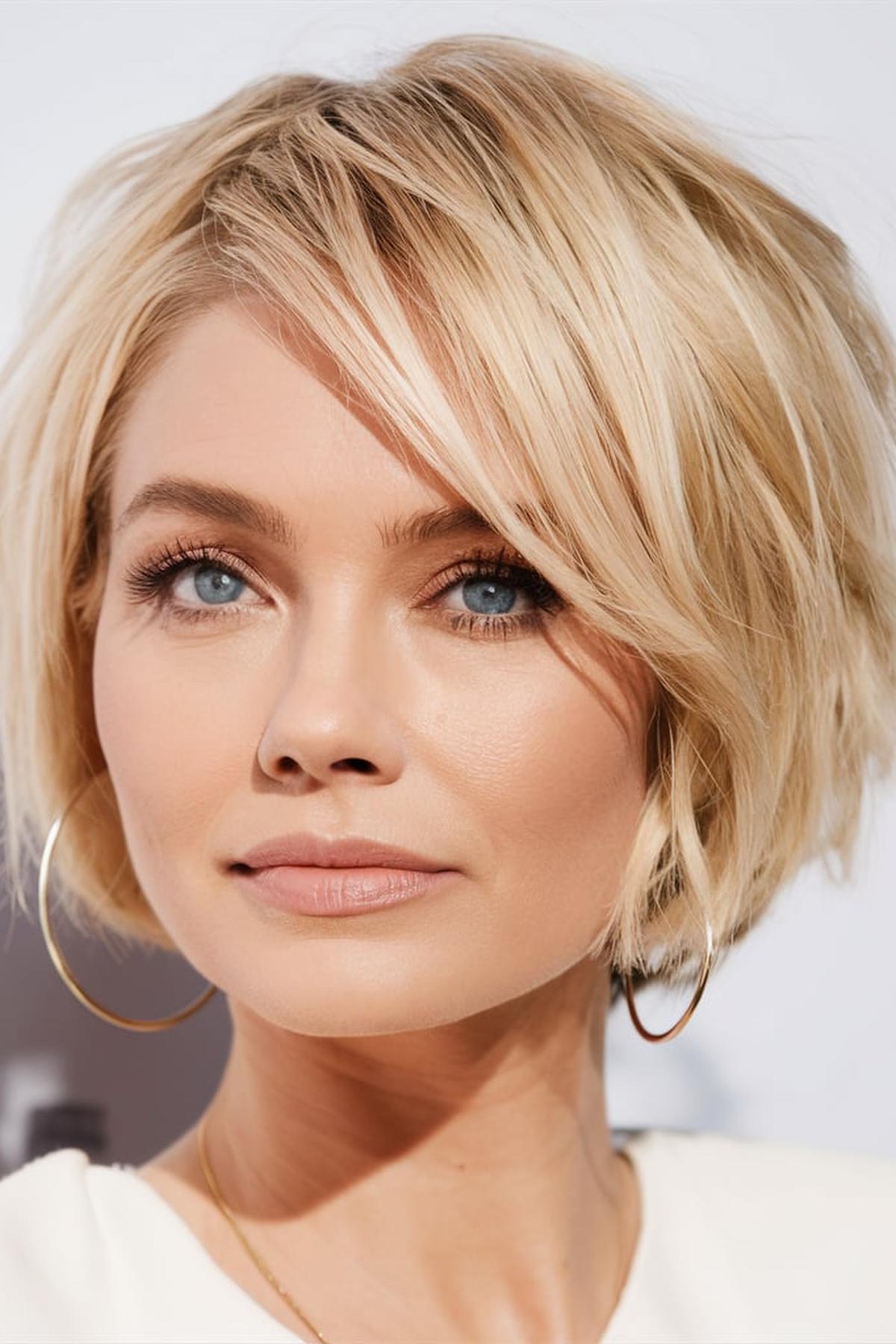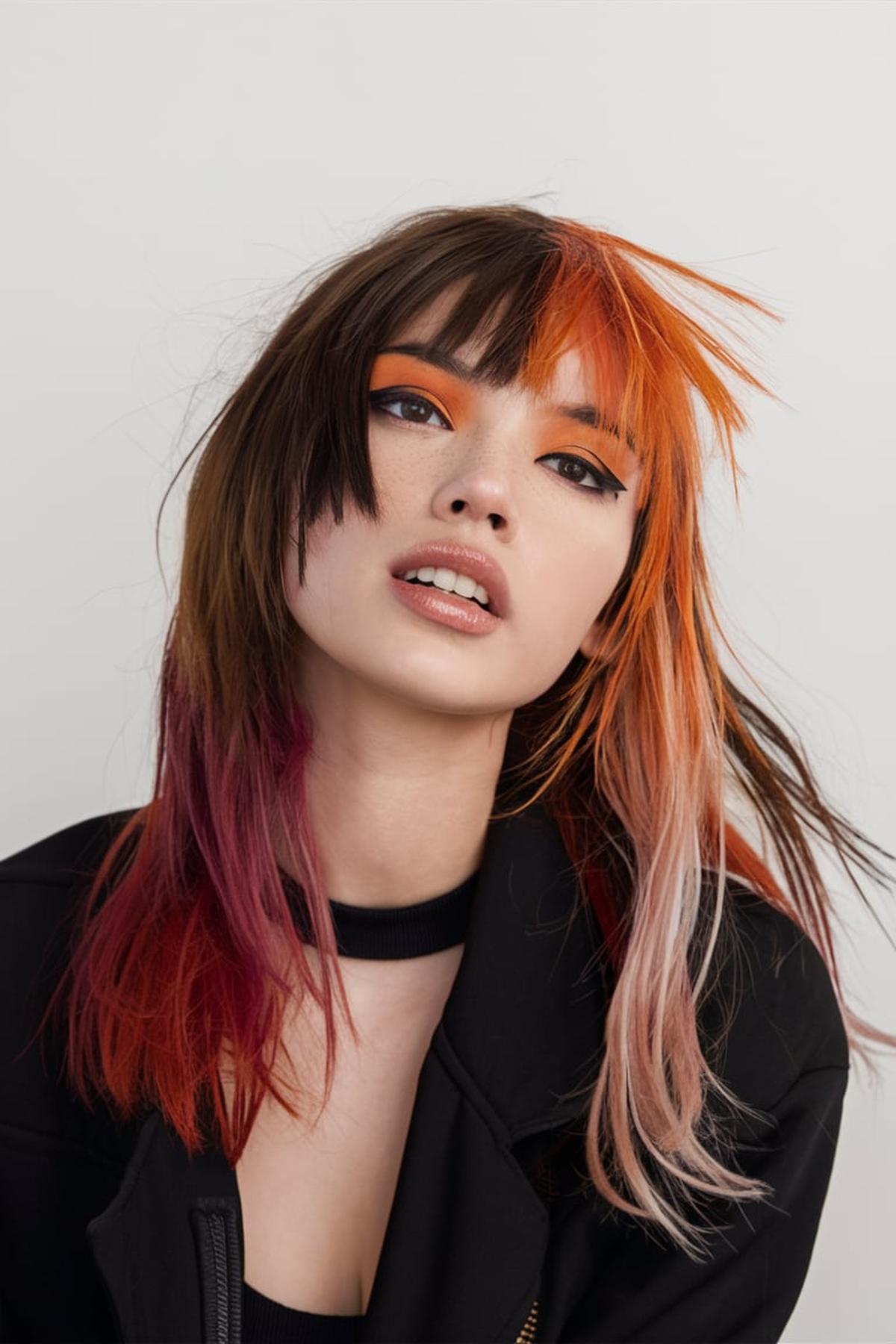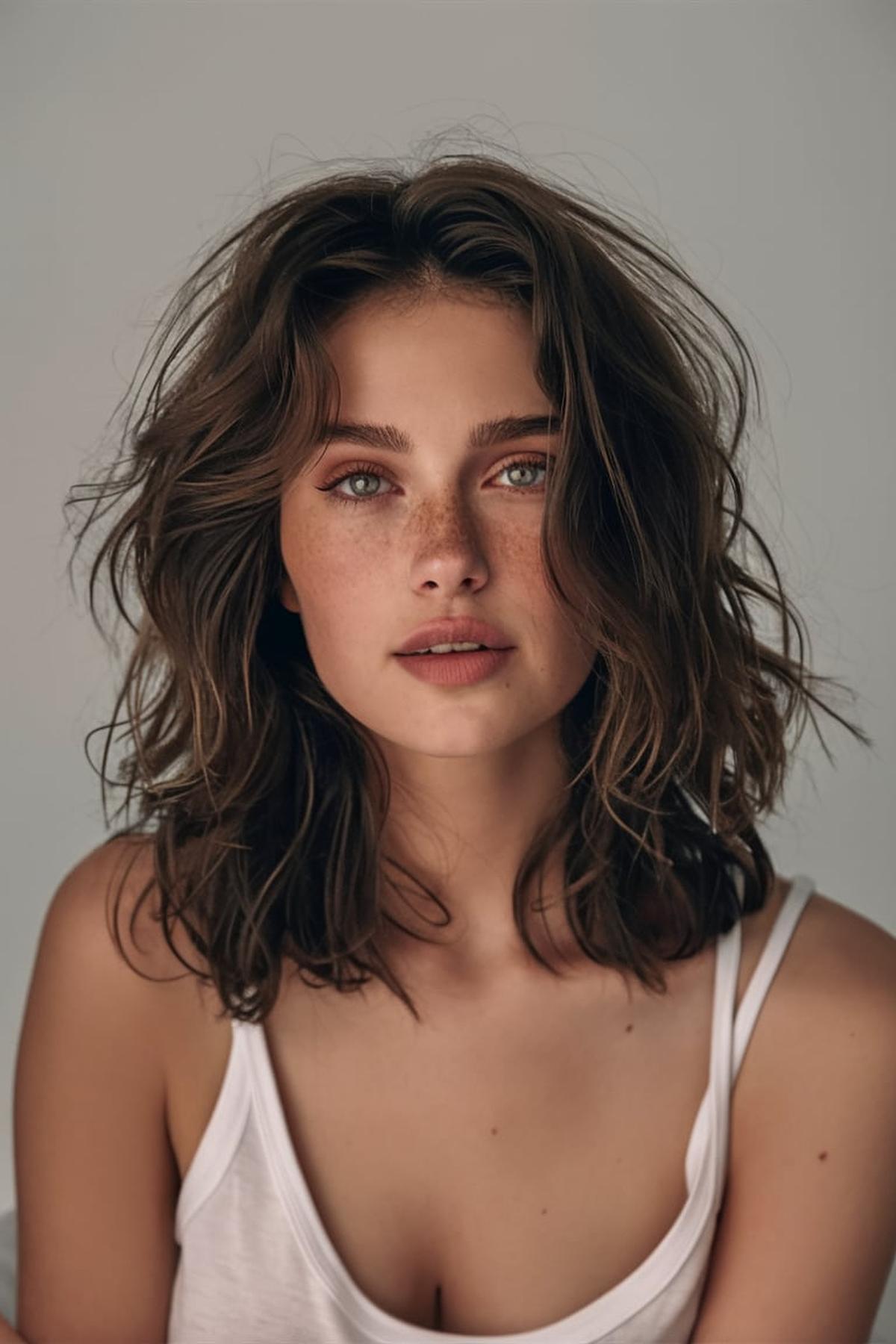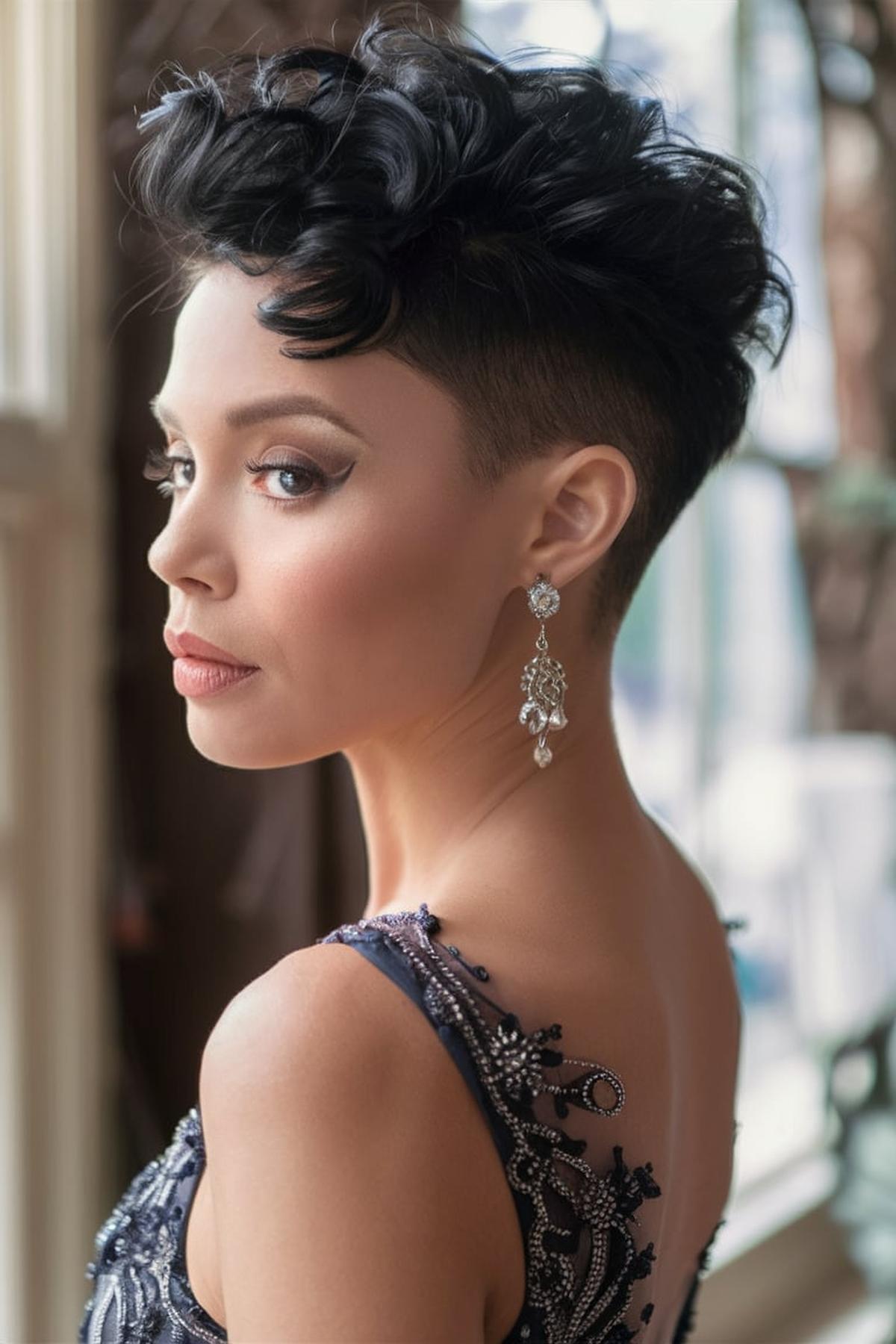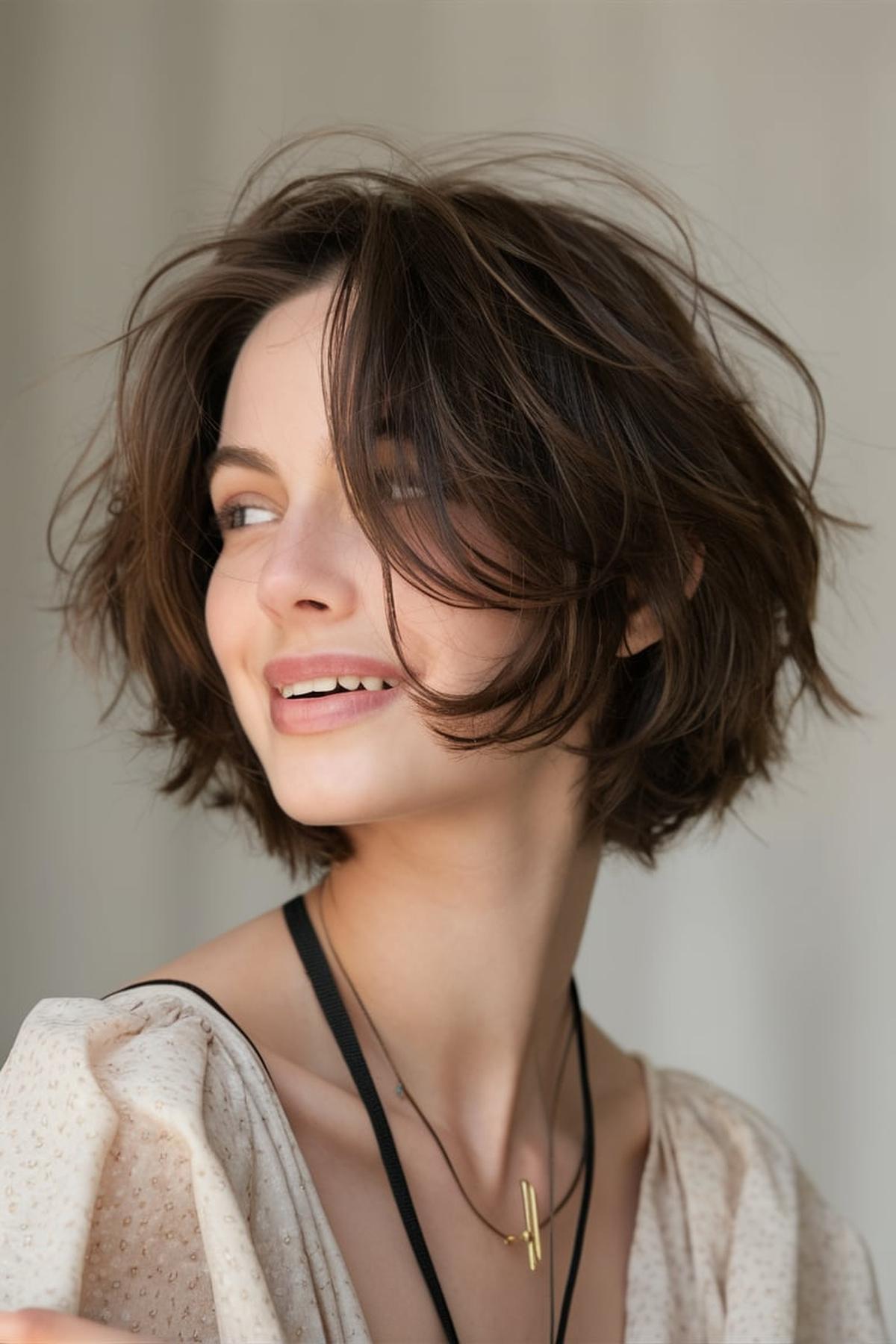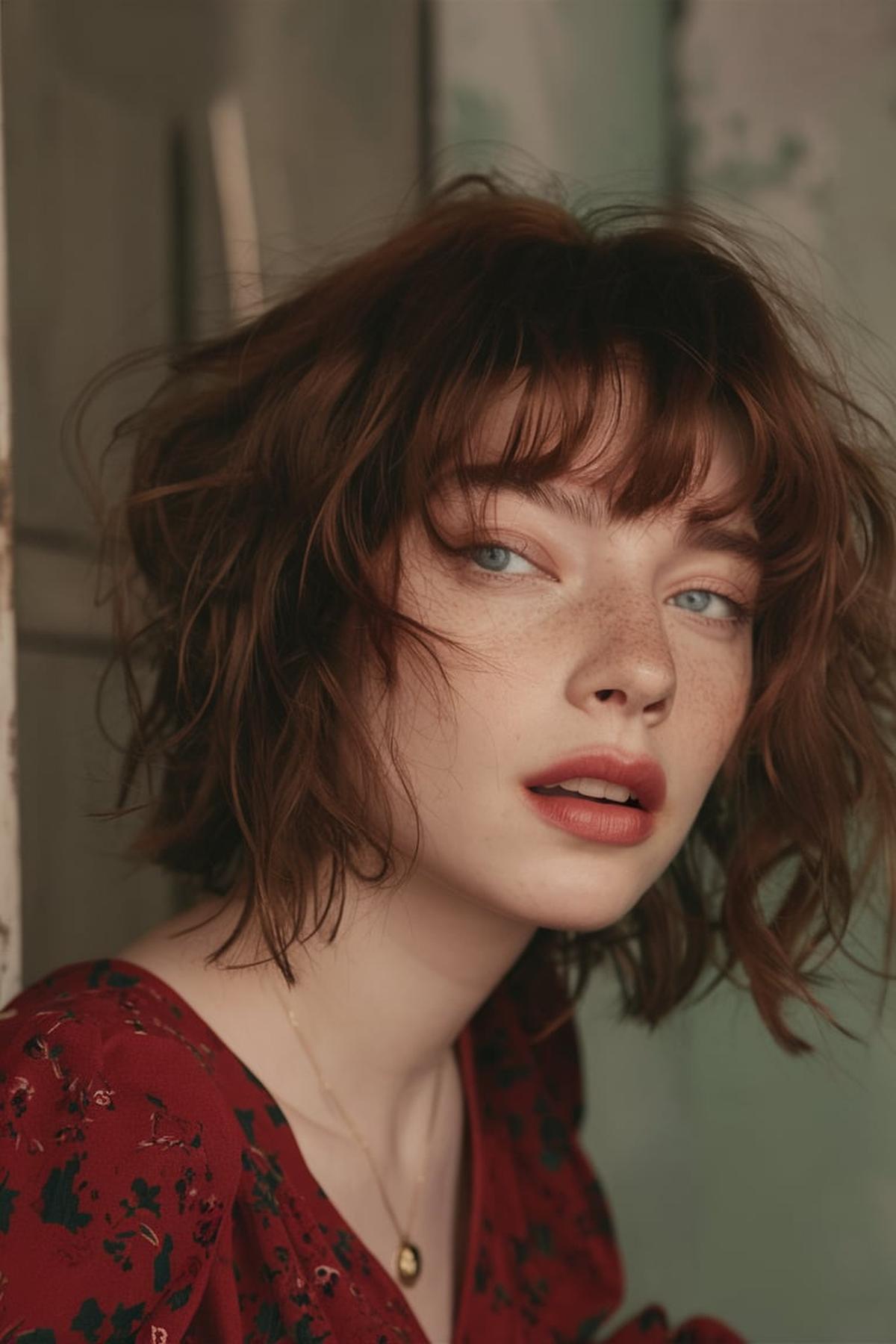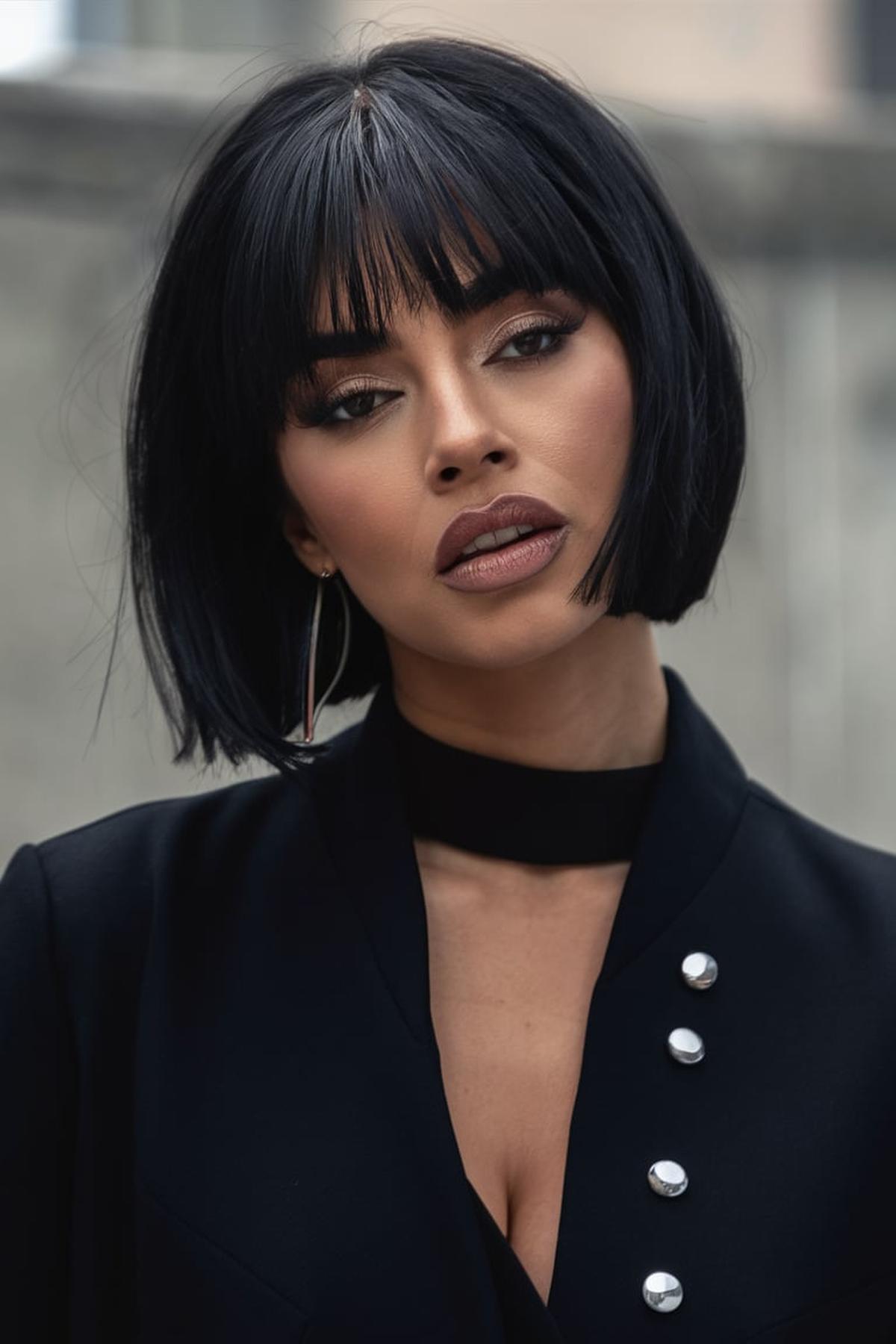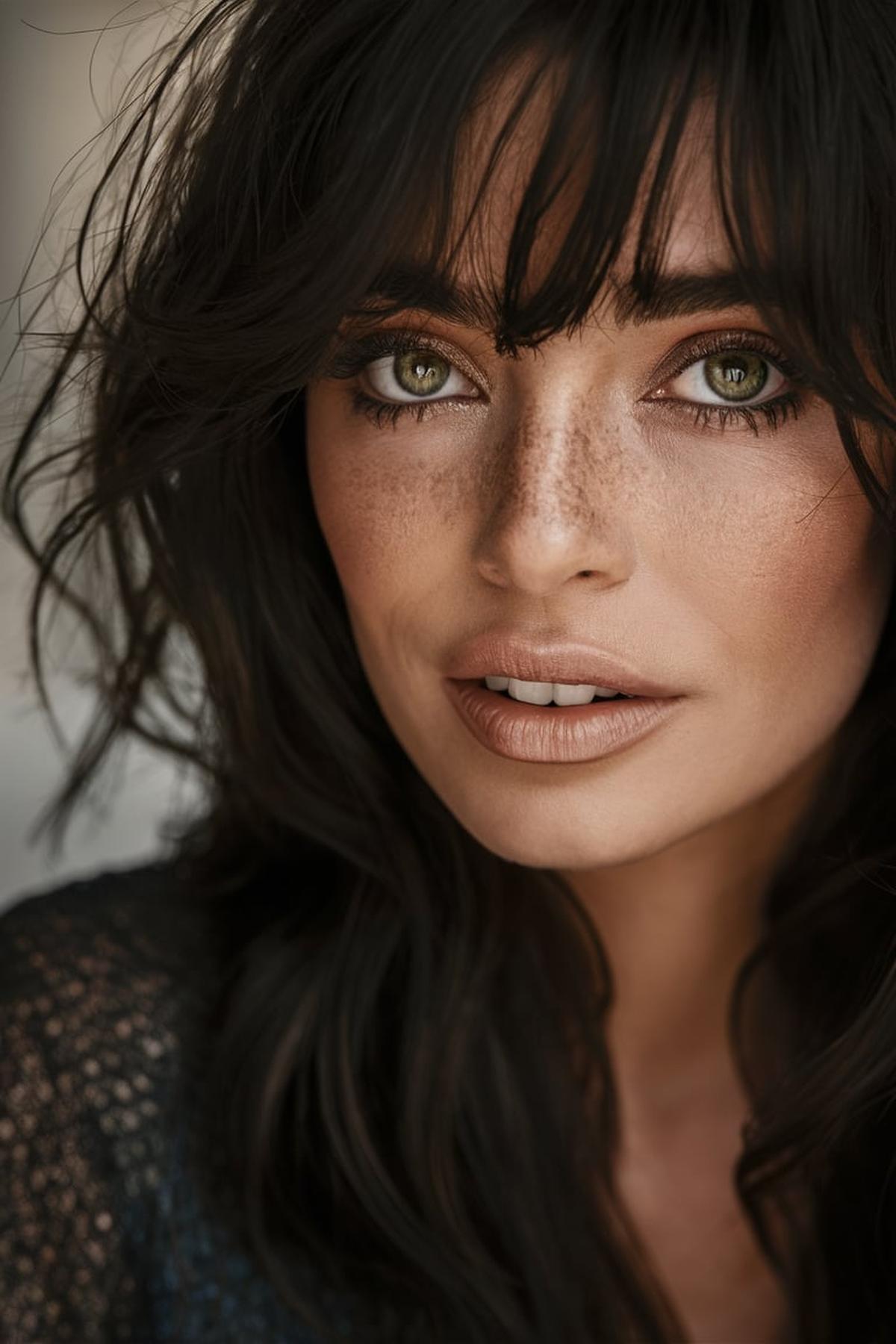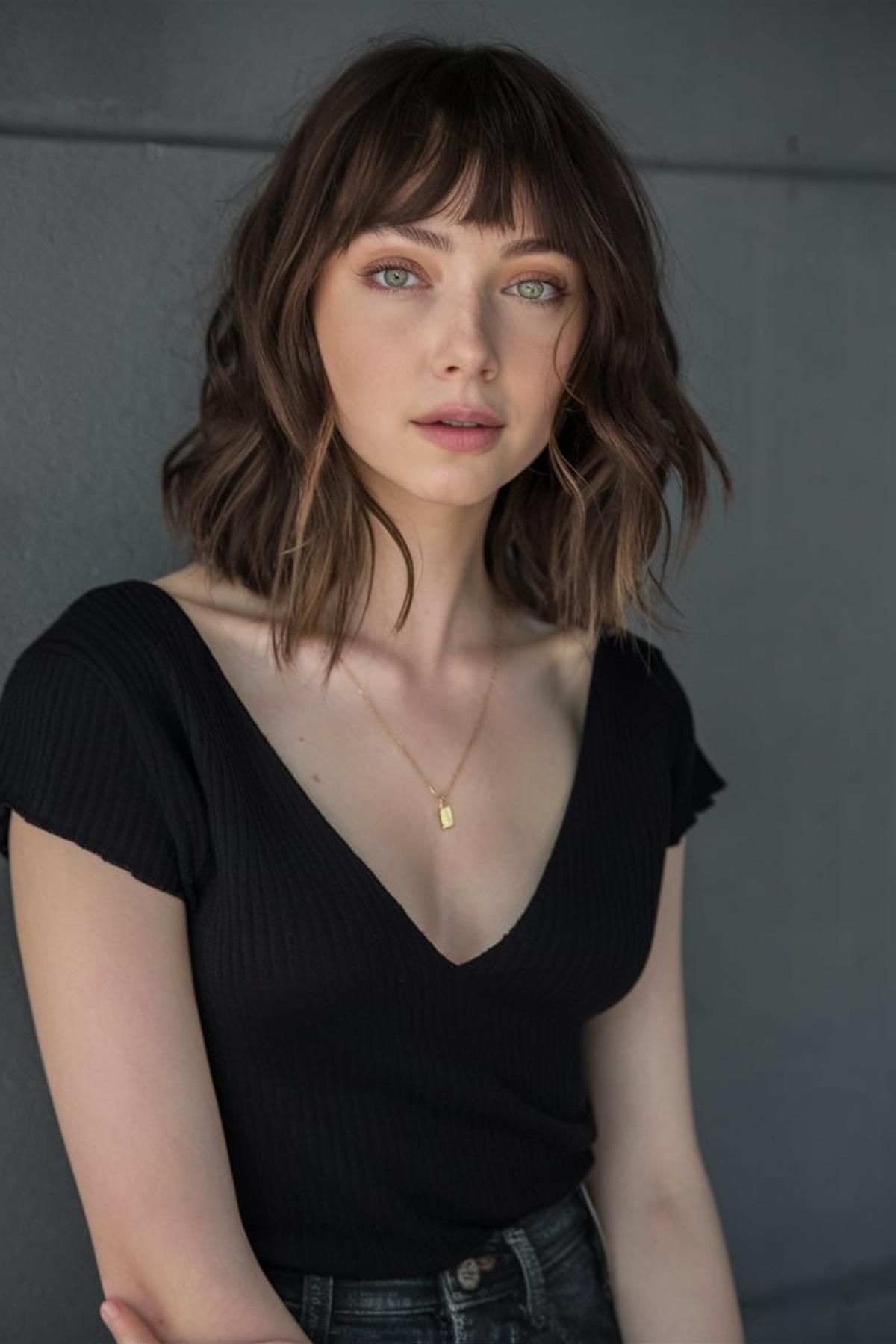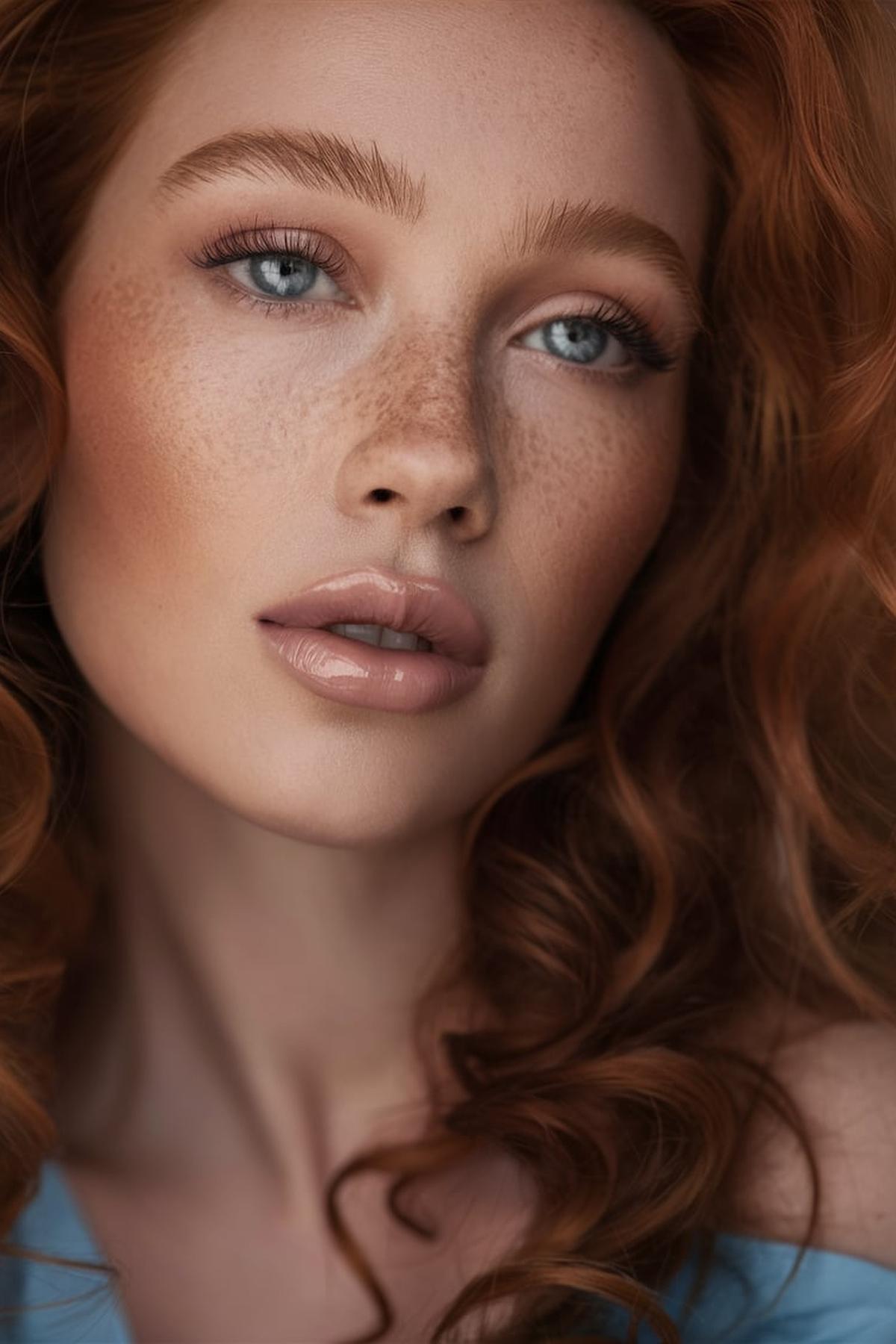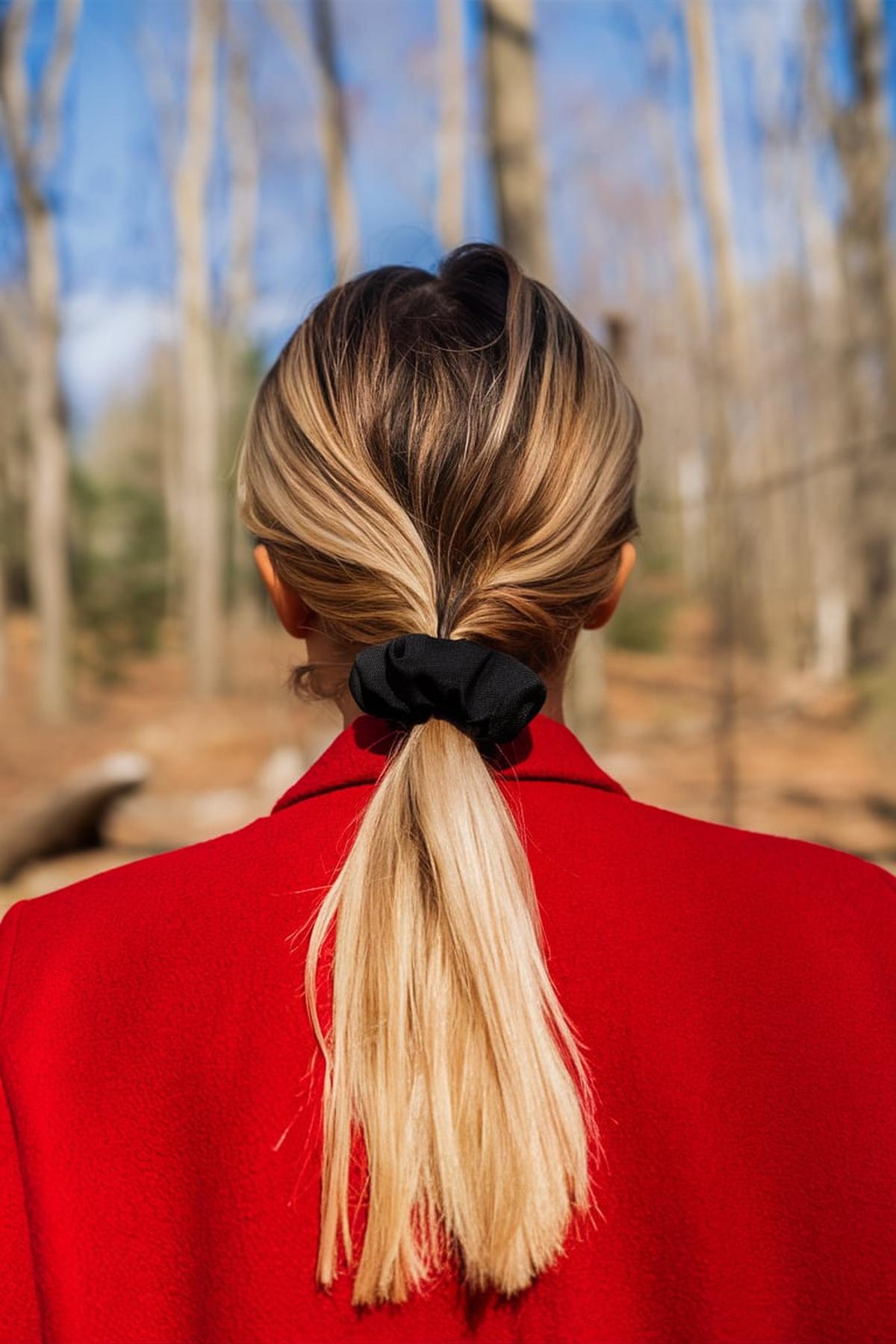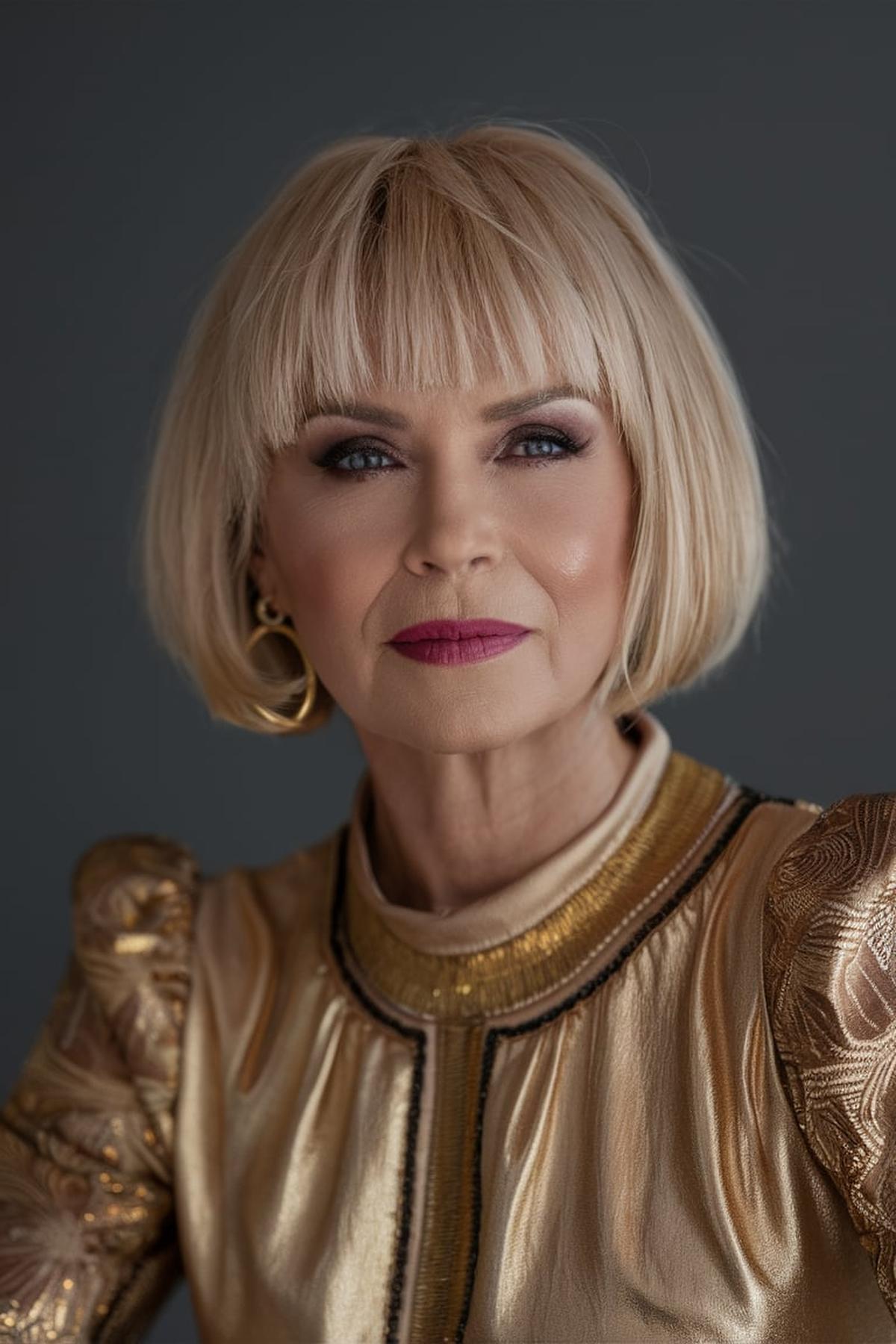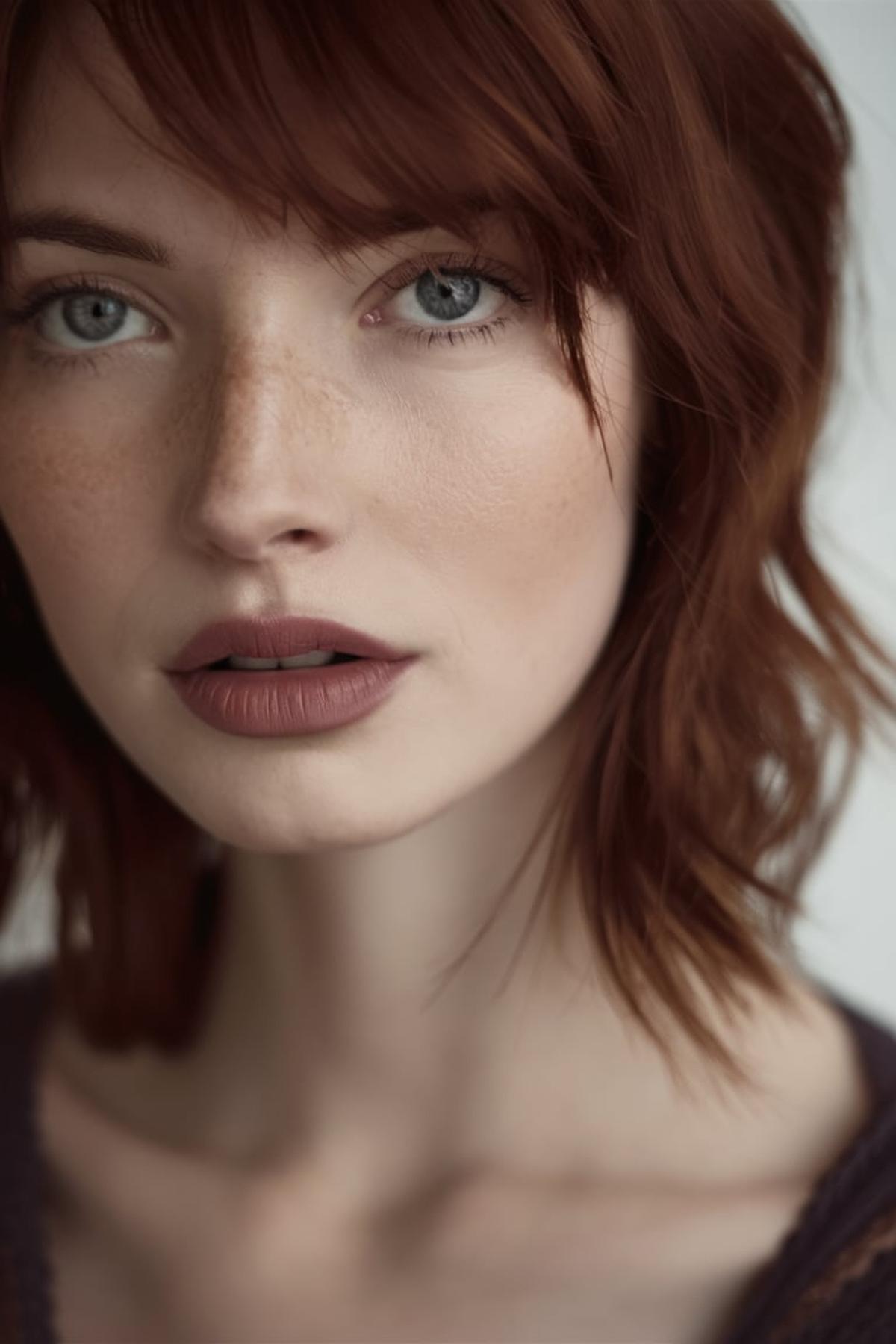Curtain bangs are a popular choice, offering a soft, retro vibe that frames the face beautifully. They work well with both long and short hair and can be styled to suit various looks. For a bold statement, blunt bangs provide a striking contrast and can be paired with sleek hairstyles or messy textures for a more relaxed feel.
Micro bangs are super short and trendy, giving an edgy feel, while side-swept bangs offer a classic and versatile option that can be worn with almost any hairstyle. For those with curly hair, curly bangs can enhance your natural texture, while feathered bangs provide a soft, layered look that adds movement.
Asymmetrical bangs can add an interesting twist, while angled bangs create a modern look. For a fun mix, try two-toned bangs to add dimension to your style. Whether you choose a pixie with bangs for a chic short look or a shag with bangs for a laid-back vibe, there’s a bang style for every occasion.
Now, without further ado, let’s dive into 20 amazing hairstyles with bangs that’ll refresh your look.
Curtain Bangs
Curtain bangs are longer on the sides and shorter in the middle, creating a soft, face-framing look. This style is versatile and can suit different face shapes and hair types. Many celebrities, like Ariana Grande and Jennifer Lopez, have rocked this trend, making it popular again. If you’re thinking about getting curtain bangs, they are easier to maintain than traditional bangs because they blend well as they grow out.
Wet hair can look longer than it actually is, so you might end up cutting them too short. Start by parting your hair in the middle and creating a triangle section at the front. Use hair shears to cut the bangs at an angle, starting longer than you think you want them. You can always trim more later, but you can’t put hair back once it’s cut!
After cutting, you can blow-dry them with a round brush to shape them. If you have straight hair, you might want to use a flat iron to smooth them out. For a more relaxed look, you can add some waves or curls. Curtain bangs also look great with various hairstyles, like messy buns or high ponytails. To keep them looking fresh, remember to trim them every four to six weeks and use some styling products to help them stay in place.
Blunt Bangs
Blunt bangs are cut straight across the forehead without any wispy ends, creating a bold look. They work best with straight or thick hair and are particularly flattering for oval face shapes. If you have a round face, you might want to ask your stylist for a slight arch in the bangs to help elongate your face visually.
For a sleek and straight style, you’ll need a blow dryer, a round brush, and a flat iron. Start by applying a heat protectant spray to prevent damage. Blow-dry your bangs using the round brush to lift them at the roots, then go over them with a flat iron to make sure every strand is perfectly straight.
Regular trims every three weeks will help maintain their clean cut. Since bangs can get greasy faster than the rest of your hair, using dry shampoo can help keep them fresh. If you’re not ready to commit to cutting your hair, you can also try styling techniques that give the illusion of bangs without the chop, like pinning back sections of hair. Experimenting with your bangs can be a fun way to change your look without a major haircut.
Wispy Bangs
Wispy bangs are light and feathery, giving a soft look that frames your face without covering it completely. They often stop at the eyebrows and have a textured finish, making them a great choice if you want a stylish yet low-maintenance hairstyle. This type of bang is perfect for those who want to try bangs without committing to a heavy, full fringe. Celebrities like Jenna Ortega and K-pop stars have popularized this look, making it trendy and versatile for different hair types and styles.
If you want more volume, use a round brush while blow-drying to lift the bangs at the roots. You can also use a flat iron to create a slight bend, giving your bangs a nice bounce. Light styling products like leave-in conditioner or texturizing spray can help maintain the airy texture without weighing them down.
You’ll need sharp hair scissors, a fine-toothed comb, and perhaps some texture shears for a softer finish. Start by sectioning off a small part of hair at the front, then cut in small snips to create that wispy effect. It’s best to cut less at first, as you can always trim more if needed. With a little practice, you can achieve the perfect wispy bangs that enhance your look and are easy to style.
Micro Bangs
They can give your look an edgy vibe and are popular among celebrities. However, before you decide to get micro bangs, it’s important to think about your hair type and face shape. For instance, they work best with straight hair and on people with long or oval faces.
Using a boar bristle brush can help smooth them out, and you might want to use a little heat protectant if you’re using styling tools. A mini flat iron can also be useful for getting those bangs just right. To keep your bangs looking fresh, you should wash them regularly and use dry shampoo to absorb any oil since they sit right on your forehead.
For a quick look, you can pull your hair into a messy bun or a ponytail, letting your bangs frame your face. You can also try using accessories like headbands or scarves to add some flair. Experimenting with different styles can help you find what works best for you and make your micro bangs a fun part of your overall look.
Side-Swept Bangs
Start by deciding how thick or thin you want your bangs to be. A good rule is to part your hair on the side where your bangs will fall. This helps create a natural look. When cutting, always do it on dry hair because wet hair can shrink up and end up shorter than you expect.
Next, styling your side-swept bangs is key to making them look great. Use a round brush and a blow dryer to give your bangs some volume and shape. You can also use a flat iron for a sleek look. If your bangs are longer, you might want to pin them back with a cute clip or bobby pins while you style the rest of your hair.
Plan to get them trimmed every few weeks to avoid them getting too long or uneven. If you prefer to cut them at home, just remember to take your time and cut small amounts. This way, you can keep your bangs looking stylish without too much effort. With a little practice and care, side-swept bangs can be a fun and flattering addition to your hairstyle.
Curly Bangs
First, when getting bangs, consider cutting your hair when it’s dry. Curly hair tends to shrink when wet, which can lead to cutting off more than you intended. A professional stylist who knows how to work with curly hair can help you achieve the right length without the risk of a mishap.
After washing your hair, avoid rubbing it with a towel; instead, gently squeeze out the excess water. Apply a curl cream or gel while your hair is still wet to help define the curls. You can also twist your bangs around your finger to encourage them to curl in the desired direction.
Curly bangs can get greasy or messy faster than the rest of your hair, so it’s important to wash or refresh them more often. Use your fingers to style them instead of a brush, as brushes can flatten the curls. Keeping your bangs moisturized will help them look their best, so consider using a nourishing spray or curl-defining cream regularly to keep them healthy and vibrant.
Feathered Bangs
Feathered bangs are a style where the hair is cut in layers, creating a soft, wispy look that frames the face. This style is often associated with a retro vibe, reminiscent of celebrities like Farrah Fawcett. The key to achieving this look is to have the bangs shorter at the front and gradually longer towards the sides, which gives them a light, airy feel. You can achieve feathered bangs by visiting a salon or, if you’re feeling adventurous, by learning to cut them yourself using the right techniques.
Start by drying your bangs with a round brush, lifting them at the roots to add height. You can also use a flat iron to slightly curl the ends of the bangs inward for that feathery effect. If your bangs are too straight or heavy, they might not have the desired look, so styling them with some movement is essential.
Regular trims every few weeks will help maintain the shape and prevent them from becoming too long or uneven. If you’re growing out your bangs, consider using headbands or clips to keep them out of your face while they reach the desired length. Experiment with different hairstyles, like braids or updos, to keep your look interesting as your bangs grow out. With some practice and creativity, you’ll master feathered bangs and enjoy the versatility they offer!
Baby Bangs
Baby bangs are super short bangs that sit high on your forehead, giving a bold and trendy vibe. They can be styled in various ways, such as blunt cuts or softer, wispy ends. This hairstyle works well with different face shapes, especially heart, oval, and round faces, as they can help soften your features and add a unique touch to your style.
Simply gather the rest of your hair into a high ponytail, twist it into a bun, and secure it with bobby pins. This style highlights your bangs and adds a fun, casual feel.
For instance, if you have curly hair, baby bangs can enhance your natural curls and give a playful look. Alternatively, straight hair can be styled sleekly for a more polished appearance. Don’t hesitate to talk to your stylist about which baby bang style suits you best and how to maintain it as it grows out.
Slightly Parted Bangs
Slightly parted bangs can frame your face beautifully and add a stylish touch to your look. To achieve this, you can ask your stylist for curtain bangs, which are longer and can be parted in the middle or slightly to the side. This style is versatile and works well with various hair types, making it easier to grow out if you decide you want a different look later on.
Blow-dry them in different directions to give them a natural, bouncy look. If you want to add more shape, you can gently curl the ends with a flat iron.
Regular trims are necessary to avoid them becoming too long or uneven. You can also use dry shampoo to keep them looking clean between washes. For a quick fix on busy days, pinning them back with clips or using hair accessories can also change up your look while keeping your bangs in check.
Asymmetrical Bangs
Asymmetrical bangs are cut at different lengths, creating a stylish and edgy look. They can frame your face beautifully and add a unique touch to your hairstyle. To achieve this look, it’s best to visit a salon where a professional stylist can help you.
Explain how you want the bangs to fall—whether you prefer them longer on one side or shorter on the other. It’s also helpful to discuss how much maintenance you’re willing to do. Some styles require regular trims to keep them looking fresh, while others may grow out nicely.
You can use a round brush and a blow dryer to create volume and shape. If you want a more relaxed look, try using a straightener or curling iron to add some waves. Experiment with different products like mousse or hairspray to find what works best for your hair type. The more you practice, the more confident you will feel in styling your bangs and making them a standout feature of your hairstyle.
Pixie with Bangs
Different face shapes can influence how a pixie cut looks on you. For instance, if you have a longer face, bangs can help soften your features. Similarly, if your hair is curly or frizzy, it may shrink up more when cut short, so consider this when deciding on the length.
There are many ways to do this, such as using pomade or wax to add texture and shape to your hair. You can create different looks by adjusting how you style your bangs—sweeping them to the side or leaving them straight across. Experimenting with products like hairspray can help keep your style in place throughout the day.
Pixie cuts typically require regular trims every 5-6 weeks to maintain their shape. This means you should be prepared to visit the salon often or learn how to do simple trims at home. As your hair grows, you can also explore new styles or even grow it out into a different haircut. Remember, hair grows back, so don’t be afraid to try something new and have fun with your look.
Shag with Bangs
A shag haircut is characterized by layers that vary in length, creating a messy, textured look. The bangs can be styled to be short or long, and they often frame the face nicely. When getting a shag cut, it’s essential to communicate with your hairstylist about the length and style of the bangs you want, as this can significantly affect the overall look.
To achieve that effortless shag look, you can let your hair air dry for a natural texture or use a blow dryer for added volume. Products like salt sprays can help enhance the texture and give your hair a beachy vibe. For the bangs, using a round brush while blow-drying can create a nice curve, making them appear fuller and more styled.
You can use styling creams or pastes to define the layers and bangs further. If you want more volume, consider using Velcro rollers on your bangs after blow-drying. This will give them a bouncy, fluffy look. Overall, the shag with bangs is all about finding the right balance between messy and styled, allowing for creativity and personal expression in your hair.
Straight Bangs on Curly Hair
Curly hair tends to shrink when it dries, which can make bangs look shorter than expected. To avoid this, consider getting your bangs cut when your hair is dry and styled. This way, your stylist can see how the curls will behave and cut accordingly. Also, be ready to spend some time styling your bangs each morning, as they can require more attention than other hairstyles.
After washing, apply a curl cream or gel to your bangs while they’re still wet. This helps define the curls and keeps them in place. If your bangs are unruly, you can use a curling wand to shape them or lightly straighten them for a smoother look.
Curly bangs can be unpredictable, especially in humid weather, so you might need to pin them back occasionally. Using a light hairspray can help hold your style throughout the day. Remember, the key to great bangs is practice and patience, so don’t be discouraged if they don’t look perfect right away. With time, you’ll find the best techniques that work for your unique curls and style.
Arched Bangs
Arched bangs are cut in a gentle curve rather than straight across, giving a softer look. This style suits many face shapes and adds a touch of elegance. To achieve this, you can either go to a stylist or try cutting them yourself. If you choose to cut your own, make sure to start with longer bangs since you can always trim more if needed.
You can use a round brush or a flat iron to create a smooth finish. For a more relaxed look, try curling the ends slightly away from your face. This adds volume and movement to your bangs. If your hair tends to be flat, consider using a volumizing spray before styling to give your bangs a lift.
Regular trims every few weeks will help maintain the shape and prevent them from becoming too long or uneven. You can also experiment with different hairstyles that incorporate your bangs, like braids or updos, to keep things interesting. Accessories like headbands or clips can also enhance your look while managing your bangs as they grow out. With practice and care, you’ll master the art of styling arched bangs in no time.
Braids with Bangs
Begin with a simple three-strand braid. Take a section of hair from the front, part it into three equal pieces, and cross the right piece over the middle, then the left piece over the new middle strand. Keep repeating this process until you reach the end of your hair. Secure it with an elastic.
For this, take your bangs and separate them from the rest of your hair. You can choose to braid the bangs into a small braid or twist them back and secure them with a clip. This will keep your bangs out of your face while adding a stylish touch to your overall look.
It might feel tricky at first, but the more you practice, the easier it will become. Try different styles, like a Dutch braid for a more edgy look, or a simple braid that flows into your bangs. Don’t hesitate to watch tutorials or ask friends for tips. With time, you’ll find a style that suits you and feel confident in your braiding skills.
Lash-Grazing Bangs
Lash-grazing bangs are cut to just above your eyelashes, creating a soft, flattering frame for your face. They work well with many hair types and can add a stylish touch to your look. To achieve this style, it’s important to visit a skilled hairstylist who can tailor the bangs to your face shape and hair texture, ensuring they complement your overall appearance.
Start by drying them in different directions to avoid a flat look. If your bangs are a bit unruly, using a flat iron can help smooth them out.
Bangs require regular trims to keep them looking sharp, so make sure to schedule appointments with your stylist every few weeks. You can also experiment with different hairstyles that incorporate your bangs, like a messy bun or braids, to keep your look versatile and fun. Embrace the uniqueness of your bangs, and remember that they can change your style dramatically with just a little effort!
Bottleneck Bangs
Bottleneck bangs are wider at the sides, framing your face nicely, and taper down to a narrower section in the center. This style is great for all hair types and lengths, making it versatile for anyone looking to change their look. When getting this haircut, ask your stylist for longer bangs that skim your cheekbones and gradually get shorter towards the middle, creating a soft, flattering line.
They often air dry well, giving you a natural look. If you want something more polished, blow-dry them while using a fine-tooth comb to train the hair to fall flat.
You can try a messy ponytail or even a voluminous blowout for a more dramatic effect. Bottleneck bangs are easy to grow out, so if you’re unsure about committing to bangs, this style is a great choice. With a little practice, you’ll find that these bangs can enhance many hairstyles and make your overall look more interesting.
Blended Bangs
Blended bangs are those that seamlessly integrate with the rest of your hair, creating a soft and natural look. One popular way to style them is by using a round brush while blow-drying. This technique helps to create volume and a slight curve, making the bangs frame your face beautifully.
To achieve this, gather your hair into a high ponytail, then twist it into a loose bun and secure it with bobby pins. The bangs add a playful touch to the bun, making it look more interesting. You can also pull out a few strands of hair to soften the look.
You can use a texturizing spray or dry shampoo to give your bangs a bit of lift and separation. This technique works well for both straight and wavy hair, allowing you to create a more effortless and relaxed vibe. Remember, the key to mastering blended bangs is practice and finding what styles work best for your hair type and face shape.
Angled Bangs
Angled bangs are cut shorter on one side and longer on the other, creating a stylish look that frames your face. To keep them looking great, blow-dry your bangs right after washing your hair. Use a round brush to lift the bangs and curl the ends slightly for added volume.
You can try a variety of hairstyles that complement angled bangs, such as a messy bun or a side braid. For a quick look, pull your hair into a high ponytail, then twist and pin it into a bun. This style is not only easy but also highlights your bangs beautifully.
Finally, don’t forget to use hair products that help maintain your bangs throughout the day. A light hairspray can keep them in place without making them stiff. If your bangs start to look flat, you can use a bit of dry shampoo to add volume and texture. Experiment with different styles and products to find what works best for you, and soon you’ll be rocking your angled bangs with confidence!
Two-Toned Bangs
You can go for contrasting shades, like blonde and black, or similar tones, such as light brown and dark brown. Make sure the colors complement each other and suit your skin tone. If you’re unsure, consult with a hairstylist who can help you pick the best combination. Once you’ve chosen your colors, it’s time to dye your bangs.
You can wear them straight for a sleek look or add some waves for a more relaxed vibe. To achieve this, use a flat iron for straight bangs or a curling wand for waves. If you want to add some volume, you can tease the roots slightly before styling.
Regular trims are necessary to prevent split ends and keep the bangs at the desired length. Additionally, use color-safe shampoo and conditioner to keep the colors vibrant. If your bangs start to fade, you can use a temporary color spray to refresh them between dye jobs. With these tips, you’ll be able to rock your two-toned bangs confidently!
Q&As for hairstyles with bangs
Q: What are curtain bangs, and how can I wear them?
A: Curtain bangs are longer bangs that are usually parted in the middle or slightly off-center, framing your face. They are easy to style and look great with different hair types, making them a popular choice for many occasions.
Q: What are blunt bangs, and who should try them?
A: Blunt bangs are cut straight across and can give a bold look. They work well for people with oval or heart-shaped faces and can add a stylish touch to any hairstyle.
Q: How do I style wispy bangs?
A: Wispy bangs are light and soft, often stopping at the eyebrows. To style them, you can use a detangling comb and a little heat to keep them looking smooth and airy without much effort.
Q: What are micro bangs, and are they hard to maintain?
A: Micro bangs are very short bangs that sit above the forehead. They require regular trims to keep their shape, but they can be a fun and unique style if you’re looking to change things up.
Q: How can I wear side-swept bangs for a special occasion?
A: Side-swept bangs can be styled by brushing them to one side and securing them with a pin or hair accessory. They add elegance and can be paired with various hairstyles, like updos or loose waves, for events.
